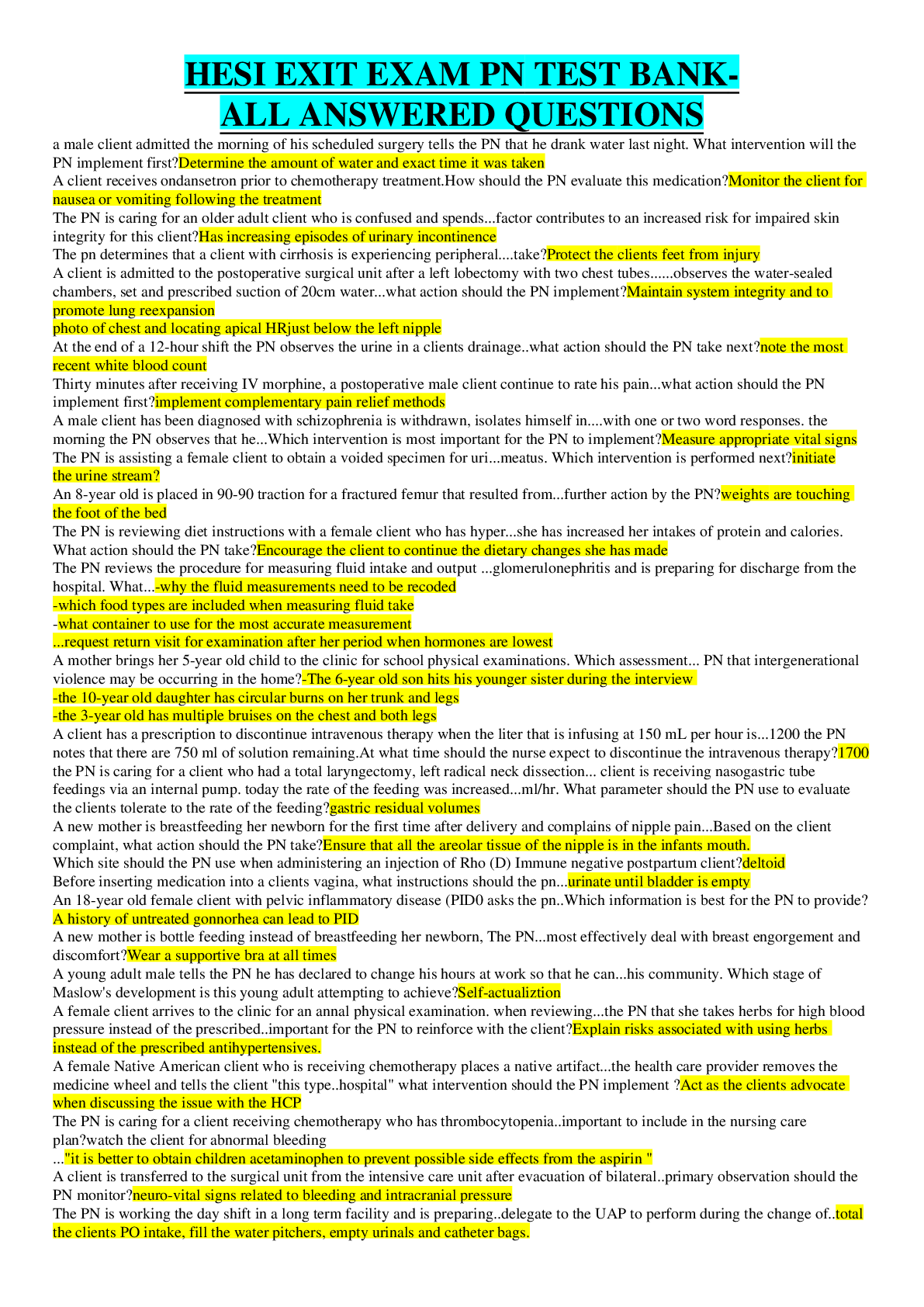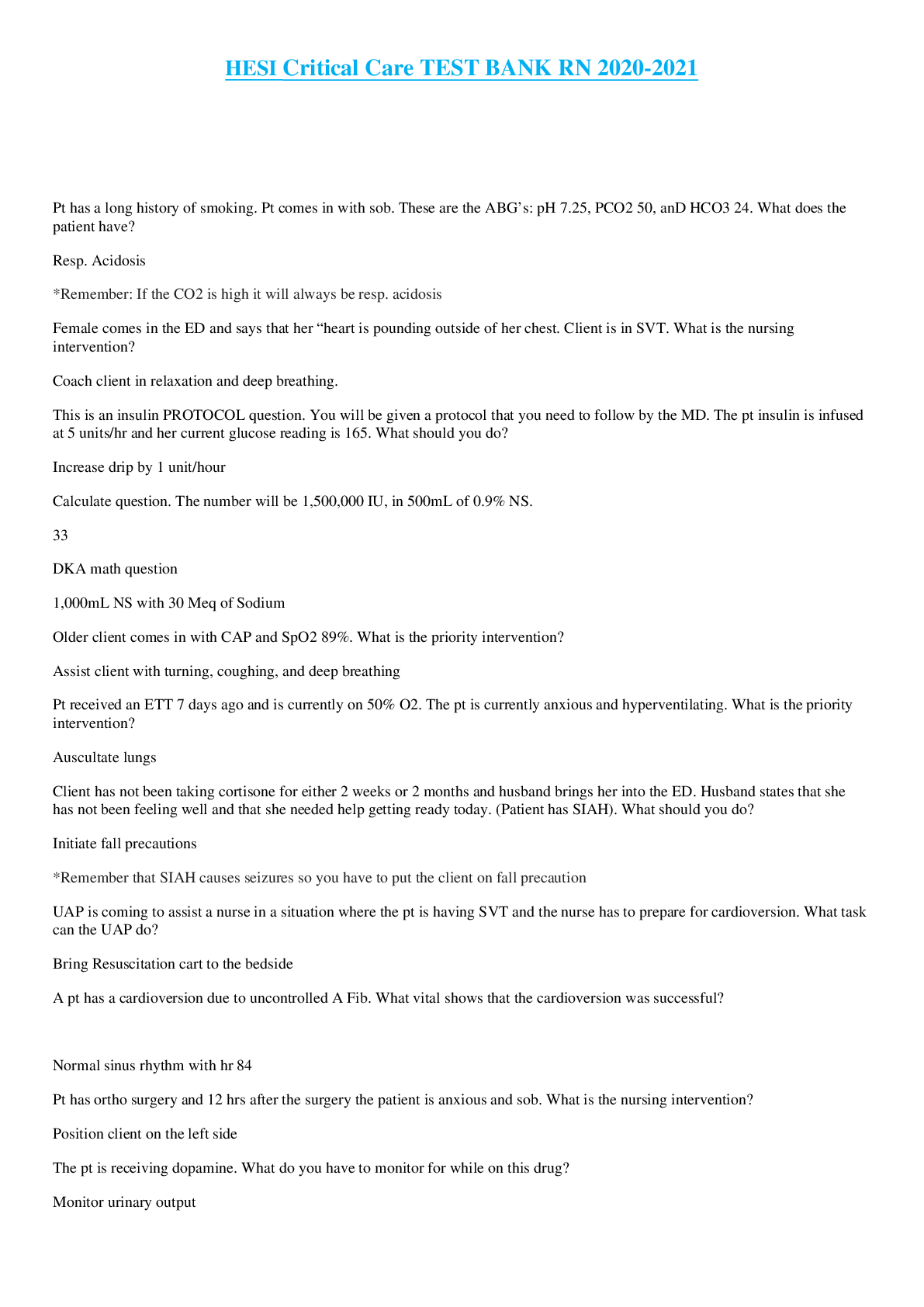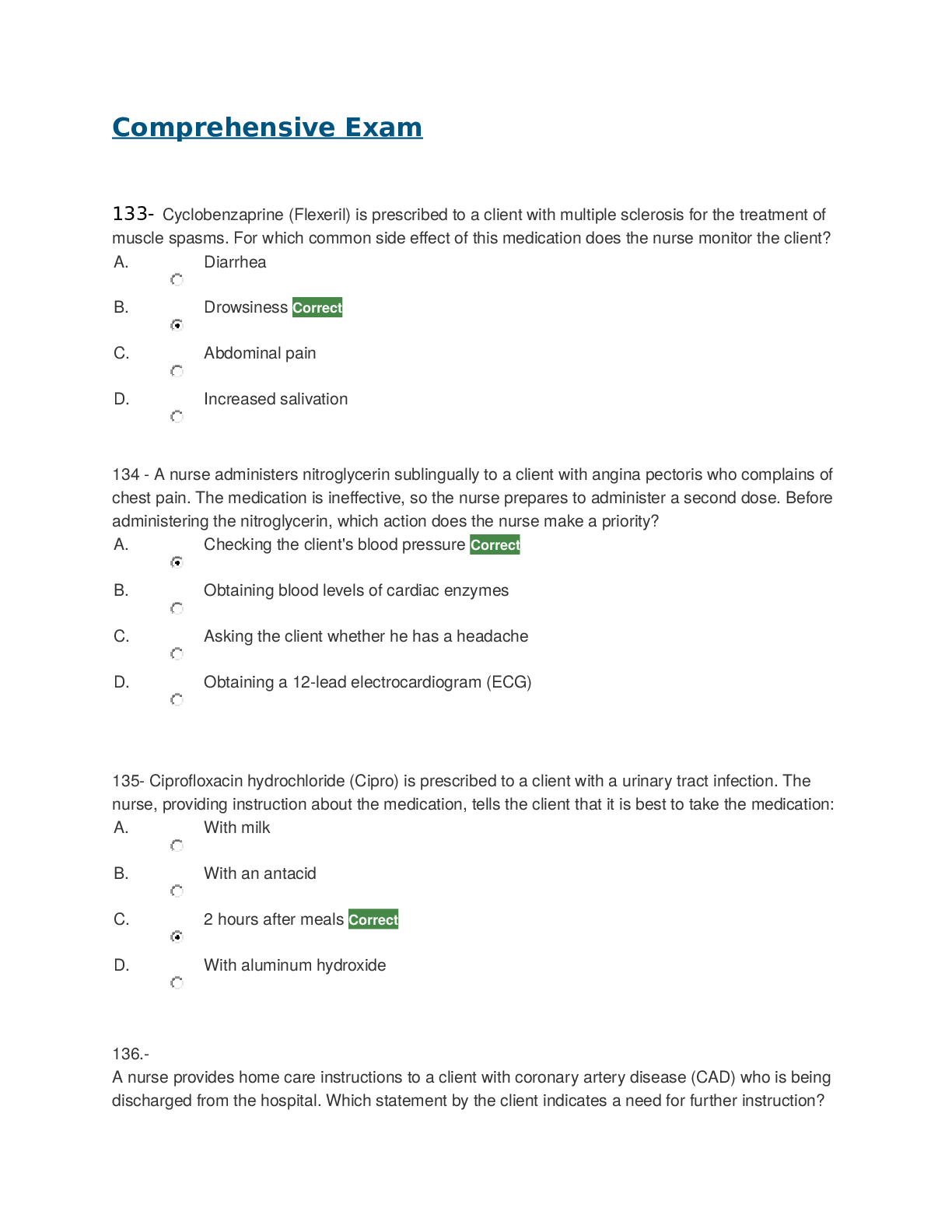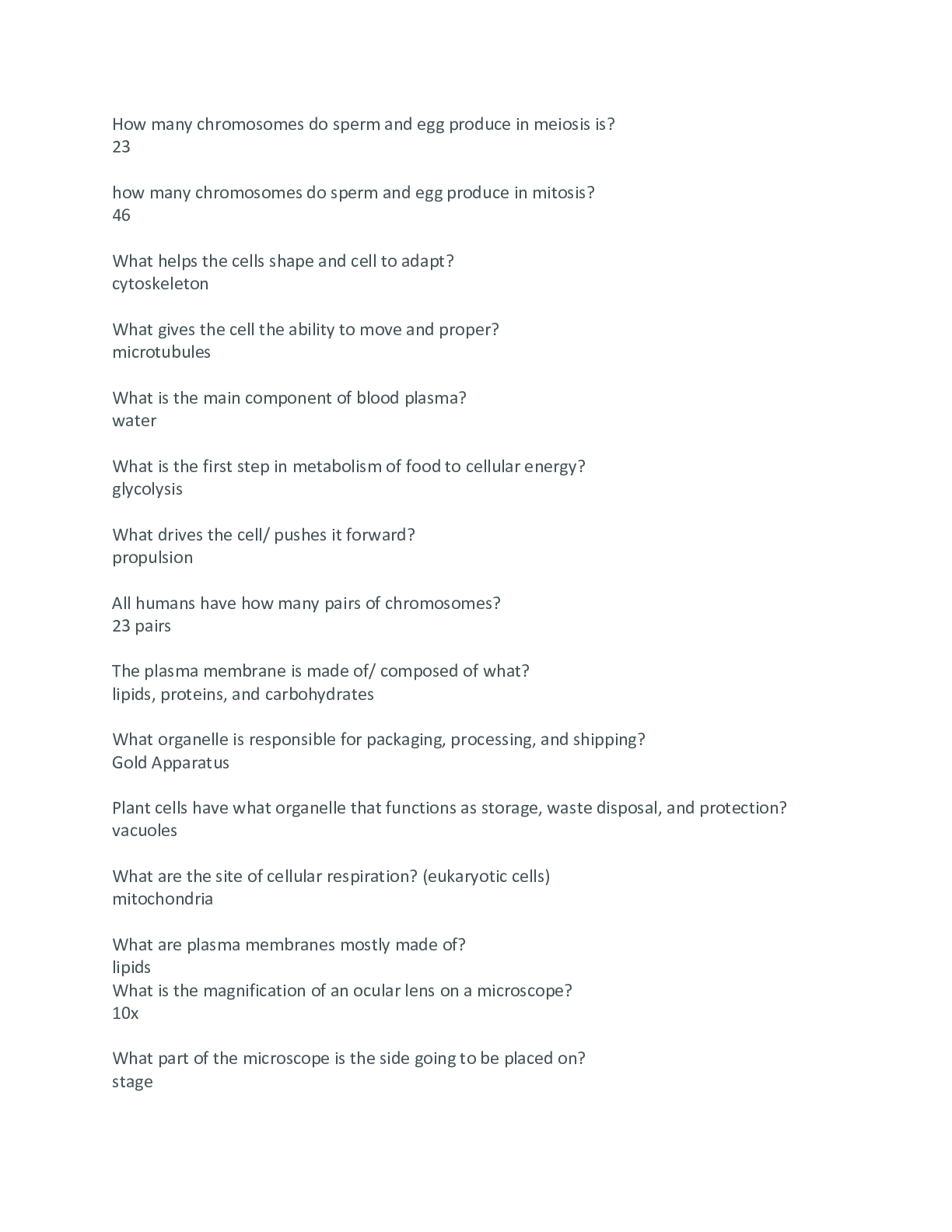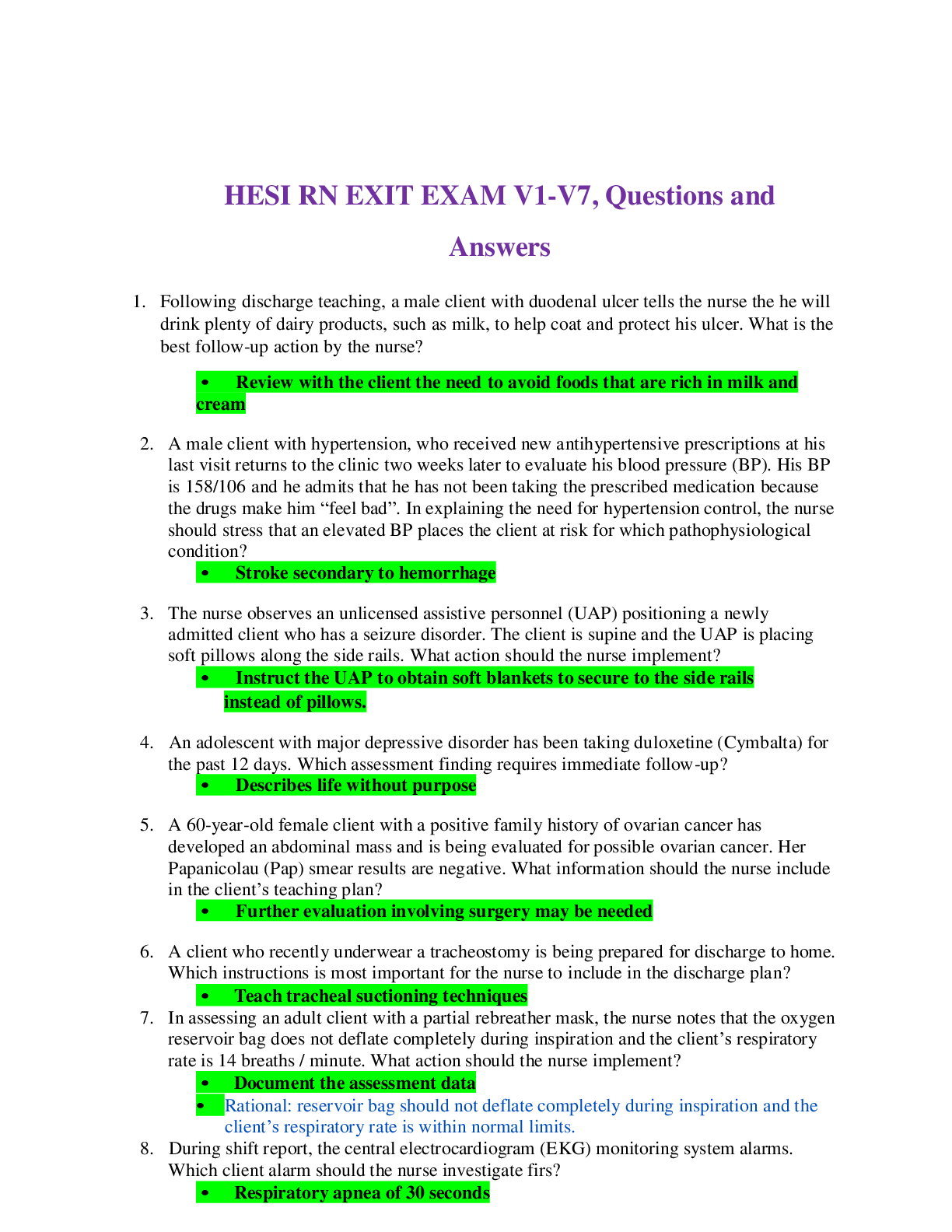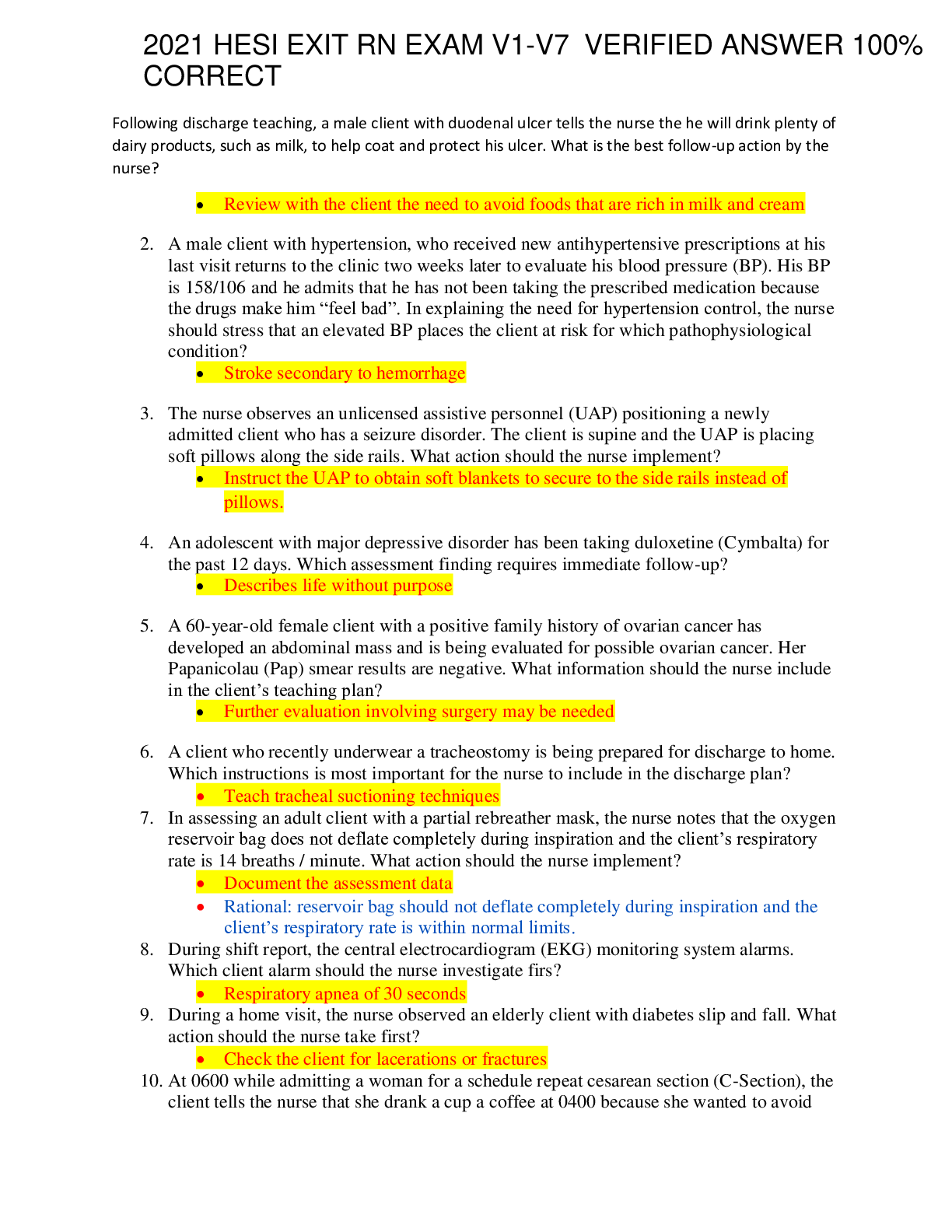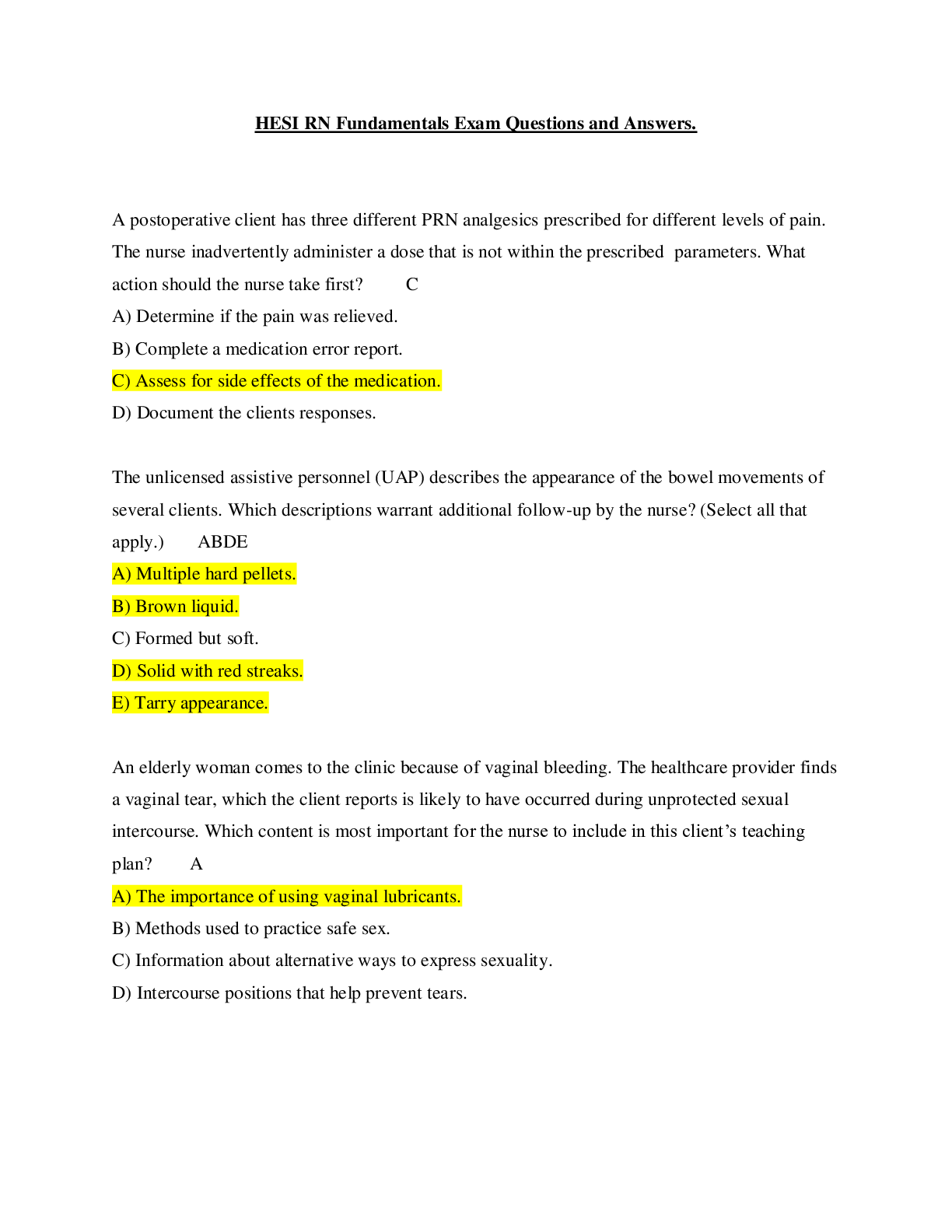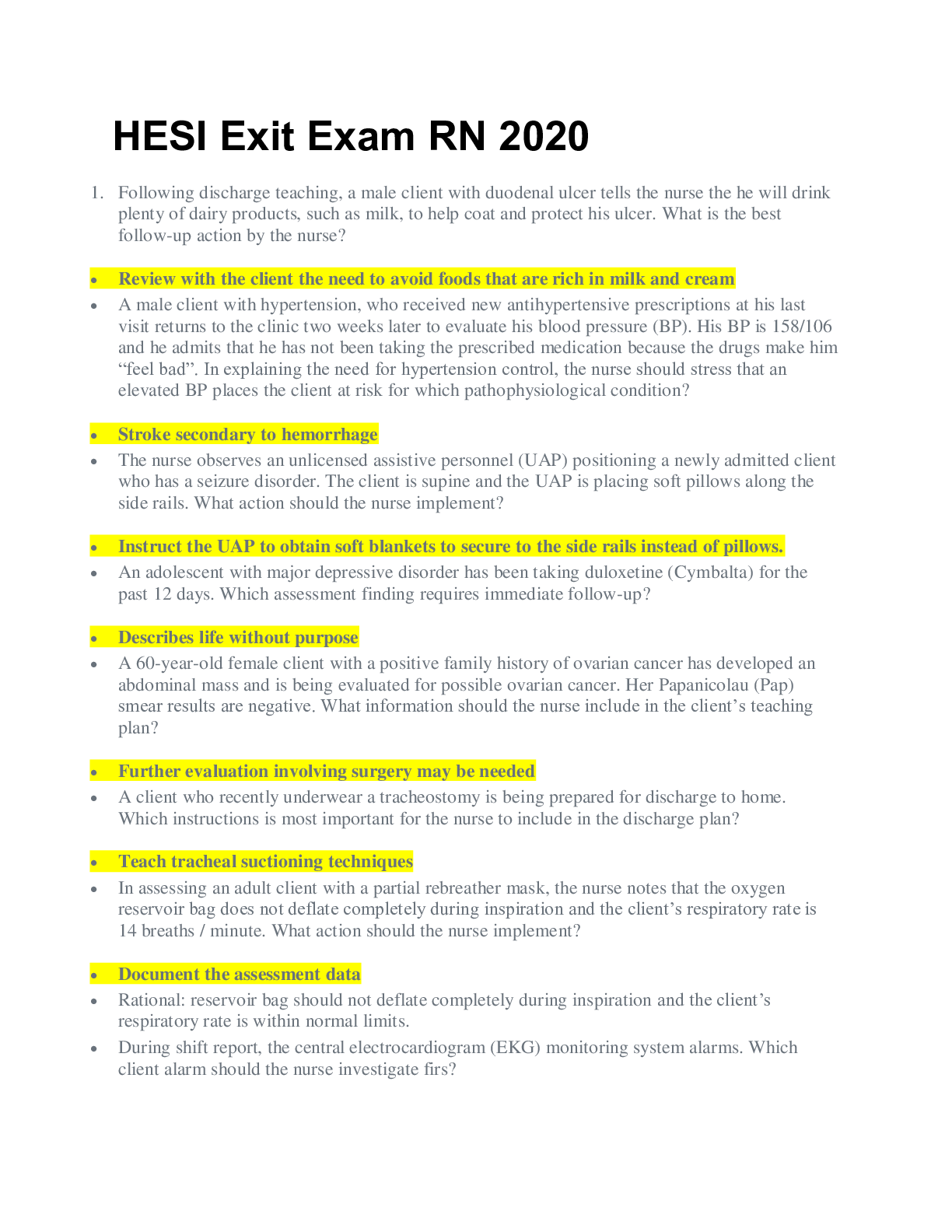Hesi A2 Reading v1 and v2 2022
Document Content and Description Below
Hesi A2 Reading Food Food and drink are necessary and desirable, but their abuse can cause serious physical and metal problem. Many physicians believe that overeating is one of the country's main h... ealth problems, since it places a great strain on the heart, can lead to diabetes, and often shortens the individual's life span. To fill an emotional void. People often turn to food when they are bored or lonely. Another area of concern is alcohol consumption. The results of alcohol abuse are widely publicized. The social drinker who becomes alcoholic, the drunken driver's contribution to highway death, spousal and child abuse, are all concomitant problems associated with alcohol abuse. 1. As used in the last sentence of this paragraph, the term “concomitant” means? *Accompanying 2. The information presented in this article is? *Unbiased in its approach 3. The author’s motive for writing the paragraph seems to have been to? *Urge self-control 4. What is implied by this paragraph? -We should eat and drink in reasonable quantities. 5. The author seems? *Favor moderation 6. The information presented in this article is -Against drinking alcohol 7. The author seems to -Oppose drinking alcoholEating Consumption of food is a universal necessity. Different cultures have developed different methods to accomplish the task. It is interesting to discover these differences and learn new ways to do things. European cultures developed cutlery (knives, forks, and spoons) to enable people to efficiently eat their food. Correct use of this tool’s changes with the times-what was polite in 1800 may not be considered proper manners today. China developed the chopstick as an efficient tool for eating. Mastery of the use of chopsticks can be difficult for the person not raised in the culture. The attempts of a novice to use chopsticks can be very amusing to the watcher, but frustrating for the hungry diner. Space travel has created new challenges for consuming food. Squeeze bottles and other unique packaging have enabled space travelers to get their needed nutrition. Chopsticks and forks do not work well in space. 1.What conclusion can be drawn about the article? A. The author think chopstick are funny B. The best way to eat food is with cutlery C. The author explains differences in eating processes. (CORRECT) D. Space flight is fun and exciting. 2.What statement can be implied from the content of article? A. Eating in space can be time-consuming. B. Diversity is interesting to learn about C. The author thinks cutlery is the best tool to use to consume food. (correct) D. The author enjoys trying new food. 3.What is the best definition of efficient as used in the third paragraph? -productive without waste 4.What conclusion can be drawn about the article? -The author explain differences in eating processes. 5.What statement can be implied from the content of article. -Diversity is interesting to learn about6.What statement from the article draws the conclusion? -it is interesting to discover new ways to do something 7.What statement from this article is correct? -china developed chop sticks for eating utensilsExams Subjective exams measure your ability in several areas. Besides recall information, you must be able to realize content logically and intelligently express yourself in a clearly understood manner. Subjective test provide opportunity for students to show their broad knowledge of a subjective area. Answers may be in the form of paragraphs or lengthy essays. When your review for an essay exam, concentrate on main ideas rather than details. Since essay tests are less to a few questions, they are likely to deal with more important ideas of a subject. Prepare a list of question you think might be asked. Write an answer to each of your questions. Rather than writing complete sentence down your thoughts in outline form. Doing so will help you organize the information so that you can express yourself clearly. When you take the test, read through all the questions before you start to write. Allot time for each question, spending more time for questions worth the most points. Read each question carefully to determine exactly what they are asked. Pay attention to words such as define, illustrate, explain, list, compare, and contrast. Each work requires a different type of response. Write a brief outline of your answer on scrap paper or the back of the test. Make sure you include all the important ideas that are within the limits of the question. In other words, do not write more than is asked for each answer. When you write your answer, keep it specific and as brief as possible. In the introductory sentence it is often helpful to make a general statement that includes important points addressed in each question. Such a topic sentence serves as a framework for your answer. Then use your outline to develop the main point and subtopics. Add substance to your answer by including as many facts as possible to support your answer. Check your paper before you submit it. Look for mistakes in grammar, spelling, sentence structure, and punctuation. Unless you are certain an answer is wrong, do not change it. Your answer is an educated guess and is usually your best chance of answering correctly. 1. When taking a subjective examination, you will find questions like. A. True & False C. Matching B. Multiple Choice D. Definitions. (CORRECT) 2. Compared to objective exams, essay test contains A. no good answers C. fewer questions (correct B. more questions D. harder questions3. From the article the reader can conclude that a test containing true-false question is called. A. subjective C. objective (CORRECT) B. rejective D. Detective 4. Compared to objective exams, subjective tests contain A. more questions. C. harder questions B. fewer questions (correct) D. no good answers 5. In answering subjective questions, the student should, A. Include more than is asked B. Keep it brief and specific C. Write out the words-true or false D. Capitalize the matching letters 6. When taking an exam, you should divide your time A. Into three or four short segments B. To allow more time for the difficult questions C. Equally between all questions D. So that you have time to check and change answers 7. In the above passage, the word "subjective" refers to test questions that: A. Allow you to choose an answer B. Are matching C. Are true or false D. Require you to write your own answerThe Game of Bridge The ebb and flow of laughter and silence fills the room as four old friends gather to engage in a round of Bridge playing. For the beginner, Bridge can be complicated, but with time, effort, and a good teacher, even the novice can become proficient. Composed of two main parts, bidding and playing, Bridge requires the player's undivided attention. The dealer deals the entire deck of playing cards evenly between the for players, with each person receiving thirteen cards. In the bidding portion of the game, the four suits of cards in the deck are ranked highest to lowest as follows: spades, hearts, diamonds, and finally clubs. However, during play all the suits of cards are considered equals, and they go from highest to lowest from the ace being high to the two cards being low. The highest number of tricks wins. A trick is one card played by each player for a total of four. After the lead player lays down his/her card, the other players follow suit, if possible. The highest card within the four "same suit" cards played wins the trick and picks up all four cards. If a player cannot follow suit, he/she plays any card, but to make the game more interesting and challenging, one suit is named a trump suit which means that if a player plays a card from the trump suit, it always wins the trick. If two cards from the trump suit are played, the highest card within the trump suit wins the trick. Obviously, the team with the most tricks wins the hand. Questions & Answers 1. The author wants the reader to feel A. As though the game of Bridge is too hard for novices to learn. B. frustrated and confused about playing bridge C. confident and excited about learning the game of bridge (correct) D. Overwhelmed by all the rules for the games of Bridge. 2. Throughout this passage the word suit means A. A set of clothing to be worn together B. Any of the four sets into which a deck of cards is divided. (CORRECT) C to be convenient or right for D. To request or appeal persistently3. In the passage, a trick is described as A. A special look given to your partner across the table B. A book that gives strategies on how to win a Bridge. C. A collection of one card played by each of four players. (CORRECT) D. A specific card the dealer gives to the person to her right. 4. The passage explicitly states A. That the highest card within the "trump" suit always wins the trick. (CORRECT) B. The Ace card is always the lowest card. C. That there is a pile of leftover" cards that is placed in the middle of the game table. D. that if a player cannot follow suit, she loses her turn to the next player. 5. The passage implies that A. playing bridge requires concentration. (CORRECT) B. Bridge is an extremely easy game to play C. Bridge is only for older people D. Bridge is only for womenThe Golden Gate Bridge Linking San Francisco to Marin County in California, the Golden Gate Bridge is one of the most famous bridges in the world. The bridge crosses over a narrow strait which connects the Pacific Ocean to San Francisco Bay. Prior to the bridge, people traveled by ferry boat across the strait. Although most people thought a bridge was necessary to expedite travel, some residents of the bay area felt the risk of building the bridge was too great. Joseph Strauss believed that nothing was impossible, and dreams would never come to fruition if risks weren't taken. So, he decided to gather the best and brightest builders, architects, and workers to embark on the challenge of building a bridge across the Golden Gate Strait. With safety nets in place, the construction began in 1937. Building the anchorages first, the builders then move on to the towers on each end, and then to the three-foot thick cables to support the suspension bridge. Lastly, workers labored to complete the roadway which became the most dangerous and treacherous part of the entire task. The builders had to keep the bridge balance, so it wouldn't fall into the bay. Today, over sixty-five years later, the bridge remains a life-line for the people of the San Francisco Bay Area. 1. The authors reason for writing this piece seems to be to A. Inform the reader (correct) B. Teach the reader C. persuade the reader D. entertain the reader 2. What body of water does The Golden Gate Bridge cross? A. San Francisco Bay B. Pacific Ocean C. Marin Strait D. Golden Gate Strait (Correct) 3. Why was the roadway so dangerous to build? A. There weren't enough materials available to build the road B. The workers might get hit by passing cars. C. The men would fall to their deaths. D. If the road wasn't balance, it would collapse. (correct)4. What is embarking? *Begin/Start/ 5. What is the first step build? *Anchorage 6.In the passage the word embark means to: A. Put or go on board a ship B. Remove the covering from a tree C. Speak harshly to others D. Being an undertakingThe Electoral College The Electoral College has nothing to do with college and contains no students. The Electoral College consists of votes that each state acquires based on the number of representatives it has in Congress. Each state has two electoral votes because each state has two senators. The remaining electoral votes are determined by the number of Congressmen, the number of which is based on the population of the state established by the Census taken each decade. During the presidential election, most states cast all their electoral votes for the candidate who wins the popular vote in that state. It’s all very confusing, but the founding fathers know what they were doing. By having and using the Electoral College candidates’ campaign in every state, but just because they win the popular vote across the country doesn't mean they will always win the election. Case in point, in election 2000, Al Gore won the popular vote across the country, but George W. Bush won more electoral votes. Therefore, he became our 43rd president. 1. Which statement from the passage is a fact? A. Each state casts their electoral votes during the Presidential election (CORRECT) B. The government randomly assigns electoral votes to states. C. Candidates only campaign in states where they think they can win. D. the Electoral College is a college in Washington D. C. 2. The author's reason for writing this piece seems to be to A. Inform the reader B. Teach the reader (CORRECT) C. Persuade the reader D. Entertain the readerVoice What effect does your voice have on others? Does it persuade or irritate, attract or repel? One of the worst qualities is harshness. If you ever get the feeling that people are uncomfortable when you speak, it may be that your harsh tones are jarring their eardrums. Your voice will sound unpleasant if it is shrill, grating, hard, piercing, brassy, to loud, or too nasal. Harsh voice qualities usually come from too much tension in the throat and jaw. Tension tightens muscles and blocks the relaxed voice tones essential to a pleasing impression. Because tension occurs in higher pitched voices, women tend to have shriller voices than men, which usually makes them less desirable public speakers, newscasters, or political candidates. 1. Which statement from the selection presents a fact rather than an opinion? A. One of the worst voice qualities is harshness. B. Harsh voice qualities usually come from too much tension in the throat and jaw. C. Your voice will sound unpleasant if it is shrill, grating, hard, piercing, brassy, too loud, or too nasal. D. Because tension occurs in higher pitched voices, women tend to have shriller voices than men, which usually makes them less desirable public speaker, newscasters, or political candidates. 2. What is stated in this paragraph? A. Some men have harsh voices. B. Relaxed people often have harsh voices. C. Women make less appealing political candidates. D. Not everyone finds a harsh voice irritating. 3. The information presented is A. Slanted in favor of newscasters B. Slanted against people with deep voice C. slanted against people with piercing voices. D. balance in its approach. 4. The author seems to: A. prefer low pitched tones (CORRECT) B. be an experienced public speaker C. prefer shrill, grating, and brassy voice D. have no reactions to different voices.THE WHITE ELEPHANT Centuries ago, in the country of Siam, now known as Thailand, it was the custom of the rulers that displeased them by giving the offender a white elephant. Because the animal was could not be made to work as other elephants did, but still had to be fed hundreds of pounds of fruit and cared for in the most lavish style. The recipient could not give the elephant to anyone else, as it was the ruler, who would be greatly displeased should the recipient not receive the gift graciously or care for in a grand style. This monetary burden could be a major liability to the recipient and in many cases they became impoverished. This is the origin of the term "white elephant" as it is used today to denote an unwanted gift. The way of gift exchange played during the holiday season is an offshoot of this. In this game, everyone brings, and the gifts are exchanged by drawing numbers and picking a gift in turn. The second person can choose or steal the first one. It is all in good fun, and people enjoy giving silly gifts and "stealing" someone else. 1. How did the people regard a white elephant? A. If a village elder received a white elephant, the entire village shared in the supply of meat. B. People tried very hard not to offend the king, so they would not receive a white elephant C. White elephants were highly prized as they were very hard workers in the cane fields. D. The people of Siam vied for the honor of receiving the king's gift or a white elephant. 2. Where is Thailand" A. Africa B. Europe C. Asia D. South America 3.What is implied by the article? people enjoy giving/receiving gifts 4.Impoverished meaning? financially ruined 6.Why is an unwanted gift called "white elephant"? It is a rare thing to get an unwanted giftTESLA Croatian-born inventor Nikola Tesla is often called the "forgotten scientist". Although he invented the alternating current (AC) motor and developed an AC electricity generation system, he never received historical credit for many of his achievements, unlike one of his first employer and eventual nemesis, inventor Thomas Edison Tesla made the first sketches of his idea for a brushless of his idea for a brushless AC motor while he was a student at the University of Prague in 1882. His interest in electricity generation led him to Paris where he was employed by the Continental Edison Company later that year to repair Edison's direct current (DC) power plants. Two years later, Tesla immigrated to New York City and acquired a job as an engineer at Thomas Edison's headquarters in Manhattan. Edison was impressed with Tesla's work ethic and ingenuity. He challenged the young scientist to develop an improved design for his DC generators for $50,000. Tesla experimented for months, finally presenting Edison with the solution he needed. Edison reneged on the deal, telling Tesla that he didn't understand American humor. Tesla soon left Edison in order to begin his own electric light company Tesla filed and was granted more than 30 patents for his inventions in 1887 and 1888. He soon had financial backing for his ideas from one of Edison' main competitors, Westinghouse. In the 1890's Tesla experimented with x-rays, developed a high-voltage electrical transformer call the Tesla coil, and demonstrated the propagation of radio waves two years before the "Father of Radio" Guglielmo Marconi. He was also the first to harness the mammoth potential energy of Niagara Falls. He worked with General Electric to install AC generators with turbines driven by the falling waters of the Niagara River, creating the first modern power plant although a brilliant scientist, Tesla was not an astute businessman. He created his own obscurity by relinquishing royalty rights for his inventions to major corporations for the purpose of raising funds for future projects. 1. What did Tesla accomplish while attending the University of Prague? A. Improved the design for Edison's DC generators. B. Made repairs to Edison's direct current power plants. C. Made designs for a brushless alternating current motor D. Developed a high-voltage electrical transformer.2. What is the meaning of the word "mammoth" as it is used in the fourth paragraph? A. Dangerous B. Raw C. Unused D. Massive 3. What is the meaning of the word "astute" in the last paragraph? A. Unwise B. Shrewd C. Reckless D. Honest 4. What is the meaning of the word obscurity as it is used in the last paragraph? A. Poverty B. Celebrity C. Confusion D. Insignificance 5. What word means the same as relinquishing as it is used in the last paragraph? A. Maintaining B. Retaining C. Selling D. Surrendering*Homonyms*** 1. Which statement is a fact rather than an opinion? *Homonyms make learning English more challenging 2. What inference can be drawn from the article? *English is a difficult language to master 3. What conclusion can be drawn from the article? *In order to master English, the student must learn the Homonyms 4. How does the article define homonyms? *Words that sound alike and are spelled in different ways with different meaning *Getting A Goodnight Sleep*** 1. What is stated in the passage? *Physical Illness can cause Insomnia 2. Which is a solution to Insomnia? *Developing good sleep and herbs and spices 3. Sleep Apnea causes? *Chronic Insomnia 4. When the author wrote this passage, what does he/she intended? *To explain the insomnia and purpose some solution for the condition 5. Insomnia affects intellectual abilities because it? *Causes a deficit in memory, concentration, and attention*Florence Nightingale*** 1. What is pivotal? *Nursing 2. What happened after completion of her studies? *Back to London and worked at the hospital 3. What she founded when she visited the hospital *Filter, dirty bedroom 4. Why she studied secretly? *Wealthy people didn’t work at the hospital 5. Why did she have an opportunity as a child? *Because her family was rich, they had a lot of money 6. She was once a pivotal person in the area? *Patient’s Right *Facts About the One Dollar Bill 1. What did the author intend? *Share some little-known facts about the one-dollar bill 2. Why is making counterfeit copies of the one-dollar bill difficult? *The formula for the ink used is kept a secret 3. What is implied by the message, The One Dollar Bill? *Is a fabulously historical document 4. In the third sentence of the passage, the word minute means? *Extremely small 5. We often accidentally wash dollar bills, why is this not a problem? *Because the dollar bills are made of cotton and linen, so they wash easily.Phobias 1. According to the passage, which of the following are types of phobias? (Put all that apply) *Social phobias, panic disorder, anxiety phobia 2. What does the author want the reader to know about phobia? *That phobia is debilitating 3. The passage says that being afraid is normal and good, according to the passage why is having a phobia not normal and good because of phobia? *Are extreme and unreasonable *Factory 1. The information presented in this paragraph? *Balanced in its approach 2. What is the best definition to the word “execution” as it is used in the last sentence of this paragraph? *Implementation or Design 3. The paragraphs suggest that the purpose of a factory layout is for? *Safety and profit 3. The paragraph states that both labor and management? *Can benefit from a well-designed factory 4. The author’s reason for writing this composition seems to have been to? *Persuade people to modernize factory design*Violence 1. Based on this reading, early research indicates that the relationship between violence in the television and violence on the street? *Appears Probable 2. The author seems to support? *Further research into the effects of television violence 3. The theme of this article seems to be? *To inform people about the debate over the television violence 4. The paragraph described television executive as? *Responsive to public demands Getting a Good night’s sleep 1.Why the author wrote this passage? -to explain insomnia& propose some solutions for the condition 2.Sleep apnea causes? -Chronic illness 3. Insomnia affects intellectual abilities because it -causes a deficit in memory, concentration, and attention 4.What is stated in the passage? -physical illness can cause chronic insomnia 5. Which is a solution for insomnia? -developing good sleep habits and taking herbs and spicesSafe Driving 1. What is the best meaning of the word advocate as used in the fourth sentence of this paragraph? -supporter 2.What is stated in this paragraph? -each individuals driving behavior is the key to automobile safety 3.What is implied by this paragraph ? -Government action will not help if individual drivers do not cooperate 4.The author seems to think that? -all cars should be properly inspected 5.the authors motive for writing the paragraph seems to have been to? -get people personally involved with traffic safetyThe Start of V2 The Water Cycle Water is needed to sustain practically all life functions on planet Earth. A single drop of this compound is composed of an oxygen atom that shares its electrons with each of the two hydrogen atoms. The cycle starts when precipitation, such as rain, snow, sleet, or hail, descends from the sky onto the ground. Water that is not absorbed immediately from the precipitation is known as runoff. The runoff flows across the land and collects in groundwater reservoirs, rivers, streams, and oceans. Evaporation takes place when liquid water changes into water vapor, which is a gas. Water vapor returns to the air from surface water and plants. Ultimately, condensation happens when this water vapor cools and changes back into droplets of liquid. In fact, the puffy, cotton clouds that we observe are formed by condensation. When the clouds become heavily laden with liquid droplets, precipitation ensues. 1. What is the meaning of the word composed in the first paragraph? A. To consist of B. To be uniquely discovered C. To be set apart D. To be surprised 2. What is the main idea of this passage? A. Water is formed from the joining of two hydrogen atoms to one atom of oxygen. B. Water is a versatile and important universal solvent. C. The different components of the water cycle are precipitation, evaporation, and condensation. The explanation of the different components of the water cycle D. Rain is a trivial part of the life cycle.3. Which statement is not a detail from the passage? A. A single drop of water is made of a couple of hydrogen atoms and oxygen atoms. B. Evaporation takes place when liquid water changes into water vapor. C. Water that is not absorbed is called runoff. D. Condensation fails to happen when water vapor cools and changes back into droplets of liquid. 4. What was the author's primary purpose for writing this essay? A. To persuade the reader to conserve water B. To persuade the reader that runoff is not the best way to collect water C. To analyze different types of runoff D. To inform the reader about the stages of the water cycle 5. What can the reader conclude from this passage about ponds and lakes? A. They are examples of groundwater reservoirs. B. They are not important in the collection of runoffs. C. They do not play a role in water collection. D. They consist of only water collected through precipitation. 6. Knowing that the cooling of water vapor results in condensation, one could conclude that _______ is/are a factor in the evaporation process. A. Humidity B. Heat C. Electrons D. RunoffAmazon Rainforest About 6% of the earth is covered by rainforests. The largest rainforest in the world is the Amazon Basin, which stretches over 2.3 million square miles in nine different South American countries. This area is double the length of all the other remaining rainforests in the world. Brazil contains 60%of the Amazonian rainforest, since it lies at the mouth of the river Amazon. This river is the second largest in the world and contains more than one-fifth of the world’sfresh water. The Amazon rainforest is a type of wet broadleaf forest. The weather there is very humid and warm as it rains quite a bit. Because of the high rainfall, the forest is very rich and green. The tree leaves are pointed and narrow so that the raindrops can easily drop off wet plants. This tropical rainforest has more living species than the entire European continent. There are over 400 types of insects living in one single rain forest tree for a total of 2.5 million species. One square kilometer of rainforest may contain over 75,000 types of trees and approximately 438,000 different kinds of plants, which comes to a total of 90,000 tons of greenery overall. The Amazon rainforest is home to 2,000 birds and mammals, with one in every five birds in the world living there. Local farmers have lived off this rich and diverse land for thousands of years. They have been able to find food and water here without destroying the land. The Kayapo people of Brazil farm in an environmentally-friendly way. Instead of chemicals, they use burned wood to enrich the soil, and plant banana trees, which attract wasps. These wasps then feed on leafcutter ants and get rid of these harmful insects. The rainforest also offers a lot of tropical fruits, such as bananas and coconuts, as food. Cinnamon is made from the bark of a rainforest tree. Amazonian Indians use the fruit and stem of the Buruti plant as a drink, to make bread and to build houses. Many other plants are used as medicine. But the Amazon rainforest is in very big danger of disappearing. 9,169 square miles of forest have been cut down in 2003 in Brazil alone. An area of the size of a football field is burned down basically every minute, which means that the rain forest may be gone by the year 2030.The dangers related to this type of activity are obvious. Trees take in poisonous carbon dioxide from the air and give off oxygen. There is more oxygen and less carbon dioxide around a rainforest. When trees are cut down, however, the amount of carbon dioxide increases, and the air gets warmer. This leads to global warming, which is extremely harmful to the environment. It is estimated that the burning of Brazilian rainforests alone produces 200 million metric tons of carbon dioxide ayear. Another danger connected with destroying the rainforest is the disappearance of plants and animals. When trees are cut down, plants and animals have no more food left and slowly die out. Killing wild animals is illegal in Brazil, but there is plenty of stealing going on. 38 million animals are stolen and sold illegally each year. The most hunted animals are birds, especially parrots, followed by snakes and the jaguar.1. According to paragraph 1, which of the following is NOT mentioned about the Amazon Rainforest? (A)Its gross area (B)Its body of water (C)Its precipitation (D)Its extinct animals 2. How can you describe the Amazon rainforest? (Choose 2 answers) (A)It rains all time there so the forest is always green. (B)The weather is so hot that not many tourists come to visit. (C)The plants are shaped so that rainwater can pour off them. (D)There is a lot of fresh water coming from the Amazon River. 3. Which of the following is true about the Amazon Basin? (A)It is not much larger than all the other rainforests in the world combined. (B)It is more than one-fifth of all the other rainforests in the world. (C)The tree leaves there are purposely shaped as they are. (D)It is a habitat for many reptiles and plants. 4. Look at the end of paragraph 2. What does the author refer to when he says “rich and diverse land” at the beginning of paragraph 3? (A)400 types of insects in the Amazon rainforest (B)2,000 birds and mammals in the Amazon rainforest (C)The many kinds of plants growing in the Amazon rainforest (D)The large variety of Amazonian plants and animals5. What does the sentence “people of Brazil farm in an environmentally friendly way” mean in paragraph 3? (A)They do not poison the soil when farming. (B)They use natural chemicals to make the soil rich. (C)They plant and don’t cut down banana trees. (D)They do not kill insects even if they are harmful. 6. Which rainforest plant has more than one use? (A)The banana ( B )T h e co co nut ( C )Ci nn am o n (D)The Bruti plant 7. What is the biggest problem related to the disappearance of the rainforest? (A)Global warming (B)Poisoning the air (C)Burning the field (D)Cutting down treesThe Bicycle Today, bicycles are so common that it’s hard to believe they haven’t always been around. But two hundred years ago, bicycles didn’t even exist, and the first bicycle, invented in Germany in 1818, was nothing like our bicycles today. It was made of wood and didn’t even have pedals. Since then, however, numerous innovations and improvements in design have made the bicycle one of the most popular means of recreation and transportation around the world. In 1839, Kirkpatrick Macmillan, a Scottish blacksmith, dramatically improved upon the original bicycle design. Macmillan’s machine had tires with iron rims to keep them from getting worn down. He also used foot-operated cranks like pedals, so his bicycle could be ridden at a quick pace. It didn’t look much like a modern bicycle, though, because its back wheel was substantially larger than its front wheel. In 1861, the French Michaux brothers took the evolution of the bicycle a step further by inventing an improved crank mechanism. Ten years later, James Starley, an English inventor, revolutionized bicycle design. He made the front wheel many times larger than the back wheel, put a gear on the pedals to make the bicycle more efficient, and lightened the wheels by using wire spokes. Although this bicycle was much lighter and less tiring to ride, it was still clumsy, extremely top heavy, and ridden mostly for entertainment. It wasn’t until 1874 that the first truly modern bicycle appeared on the scene. (14) Invented by another Englishman, H.J. Lawson, the “safety bicycle” would look familiar to today’s cyclists. This bicycle had equal-sized wheels, which made it less prone to toppling over. Lawson also attached a chain to the pedals to drive the rear wheel. With these improvements, the bicycle became extremely popular and useful for transportation. Today they are built, used, and enjoyed all over the world. 1. Highlight the passage. Which words and ideas should be underlined? 2. The main idea of this passage is best expressed in which sentence? a. Sentence (1): Today, bicycles are so commonthat it’shard tobelieve they haven’t always been around. b.Sentence (13): It was’t until 1874 that the first truly modernbicycle appearedonthescene. c. Sentence (4): Since then, however, numerous innovationsandimprovementsindesignhave made the bicycle one of the most popular means of recreation and transportation around the world. d. Sentence (18): Today they are built, used, and enjoyed alloverthe world.3.Which of the following would be the best title for this passage? a. Bicycles AreBetter b. A Ride through the History of Bicycles c. CycleYourWaytoFitness d. The Popularity of Bicycles 4. Which sentence best expressesthe mainidea of paragraph 3? a. Macmillan was agreatinventor. b. Macmillan’sbikedidn’tlook muchlikeour modernbikes. c. Macmillan’s bike couldberiddenquickly. d. Macmillan made important changes in bicycle design. 5. An innovation, as it is used in Sentence (4), is a. a new way of doing something. b. a design. c. an improvement. d. a clever person. 6. Revolutionized, as itisused inSentence (10), most nearly means a. cancelled. b. changed drastically. c. became outdated. d. exercised controlover.7. The word prone, as it is used inSentence (15), means a. lying down. b. unbalanced. c. incapable of doing something. d. likely to do something. 8.Which of the following sentences from the passage representsthewriter’s opinion? a. Sentence (1) The safety bicycle wouldlookfamiliartotoday’s cyclists. b. Sentence (6) c. Sentence (9) d. Sentence (16) 9. Sentence (8), “It didn’t look much like a modern bicycle, though, because its back wheel was substantially larger than its front wheel,” follows which pattern? a. f act , f act b. fact, opinion c. opinion, fact d. opinion, opinion 10. Macmillan added iron rims to the tires of his bicycle to a. add weight tothebicycle. b. makes the tireslastlonger. c. makes the ridelessbumpy. d. makes the rideless tiring. 11. The first personto use a gear system onbicycles was a. H . J . L a w s o n . b. Kirkpatrick Macmillan. c. The Michauxbrothers. d. JamesStarley. 12. Starley’s additionof wirespokes madethebicycle a. lighter. b. lesslikelytotipover. c. more efficient. d. safer.Day light Savings Time It is a well-known fact that it takes the Earth approximately 365 days to move around the sun. At the same time, the Earth revolves or spins around itself over the course of 24 hours, which explains why there is day and night. One half of the Earth is always facing the Sun and the other half is facing away from it. As a result, there are different time zones dividing the globe. Moving suddenly from one time zone into the other, as when flying for example from Asia to North America, causes jetlag. People feel tired, they wake up suddenly during the night and cannot go back to sleep. It takes time to get used to a new time zone. Another thing to consider is the slight tilting of the Earth towards the sun. The Earth does not stand straight but leans a little to one side. Therefore, when it revolves around the Sun, the middle part of the Earth is always closer to the Sun and gets more heat. This part is called the equator, and above it lathes tropics. Countries at the tropics get the same amount of daylight all the time. The sun always rises at 6 am and sets at 6 pm. In contrast, the tips of the Earth or the Poles get hardly any light at all because they are so far away from the sun. There are two main seasons at the Poles. There are 6 months of summer, when the sun is always shining, even at night, and there are 6 months of winter, when there is constant darkness. In between the tropics and the Poles lies the temperate zone, where there are 4 seasons. The sun rises and sets at different times throughout the year. In the spring and summer, it gets light earlier; in the fall and winter it gets dark earlier. People who live in temperate zones take advantage of that fact to get more daylight. At the beginning of spring, countries in Europe and North America readjust their clocks. They change the time on their clocks and watches by moving them an hour ahead. As a result, the sun does not set around 7 or 8 pm as usual, but an hour later. This measure is called Daylight Savings Time (DST) and lasts until the beginning of fall, when people move their clocks back one hour to Standard or regular Time. It is thought that Benjamin Franklin first suggested the introduction of Daylight Savings Time in the 18th century. But, the first serious proposal came in 1907 from William Willet. Yet hisidea wasshelved by the British government, who refused it because they thought it was unnecessary. Daylight Savings Time was first put into practice by the German government in1916inorder to save energy duringthe First World War.Shortlyafter,the UnitedKingdom followed suit, with the United States doing the same in 1918. The law was very unpopular since people had to wake up earlier and many experienced a feeling like jetlag. But the 1970s energy crisis forced the US to make Daylight Savings Time the law. Studies have shown that the introduction of Daylight Savings Time in the spring saved the US 10,000 barrels of oil per day between 1974-1975. It also prevented 2,000 traffic injuries and 50 traffic-related deaths, saving the country $28 million. Currently, Americans switch to Daylight Savings Time on the first Sunday in April and move back to Standard Time on the last Sunday in October. But as of 2007, the time readjustment will happen even earlier,in March and November. 1. What is the main idea of this passage? (A)Time is a complicated thing to calculate. (B)People in different countries measure time in different ways. (C)Daylight Savings Time is the result of the Earth moving around the Sun.(D)Daylight Savings Time is not a very popular law in the USA. 2. What does the sentence “It takes time to get used to a new time zone.” mean in paragraph 1? (A)A flight between Asia and North America takes a long time. (B)Changing time zones makes people feel tired. (C)People need time to feel comfortable with a new time zone. (D)It may take weeks to get used to jetlag. 3. Which part of the Earth is the closest to the Sun? (A)The Equator (B)The tropics (C)The temperate zone (D)The Poles 4. It is 7 p.m. Standard Time. What time is it for Daylight Savings Time? ( A ) 6 p. m. ( B ) 8 p . m . ( C )7 a. m. ( D ) 8 a.m . 5. Was Daylight Savings Time popular in the beginning? (A)Yes, people wanted tosave energy. (B)Yes, people like staying up late in the summer months. (C)No, there was a war at that time and people hated it. (D)No, people felt tired because they couldn’t sleep that long.6. What can be inferred about Daylight Savings Time? (A)It will be modified starting in 2007. (B)It will be canceled right after the end of 2007. (C)It will be replaced with Standard Time in March 2007. (D)It will be adjusted shortly before the start of 2007. 7. Which of the following is NOT mentioned in the passage? (A)The cause of jetlag (B)The amount of daylight at the tropics (C)Why the time readjustment will happen (D)Why the British government refused Daylight Savings Time These are another set of questions and answers I found for Daylight Savings Time 1. As it is used in paragraph 3, the word obligatory most nearly means a. approved. b. sparse. c. aberrant. d. requisite. 2. Who first established the idea of DST? a. President Richard Nixon b. Benjamin Franklin c. Sir Robert Pearce d. President Lyndon Johnson3. Who opposed the bill that was introduced in the House of Commons in the early 1900s? a. Sir Robert Pearce b. farmers c. television and radio broadcasting companies d. the U.S. Congress 4. Which of the following statements is true of the U.S. Department of Transportation? a. It was created by President Richard Nixon. b. It set standards for DST throughout the world. c. It constructed the Uniform Time Act. d. It oversees all time laws in the United States. 5. Which of the following would be the best title for this passage? a. The History and Rationale of Daylight Savings Time b. Lyndon Johnson and the Uniform Time Act c. The U.S. Department of Transportation and Daylight Savings Time d. Daylight Saving Time in the United States 6. The Daylight Savings Time Energy Act of 1973 was responsible for a. preserving and setting Daylight Saving Time across the continent. b. instituting five time zones in the United States. c. extending Daylight Saving Time in the interest of energy conservation. d. conserving energy by giving the Department of TransportAll the Jazz Jazz has been called "the art of expression set to music", and "America's great contribution to music". It has functioned as popular art and enjoyed periods of widespread public response, in the "jazz age" of the 1920s, in the "swing era" of the late 1930s and in the peak popularity of modern jazz in the late 1950s. The standard legend about Jazz is that it originated around the end of the 19th century in New Orleans and moved up the Mississippi River to Memphis, St. Louis, and finally to Chicago. It welded together the elements of Ragtime, marching band music, and the Blues. However, the influences of what led to those early sounds goes back to tribal African drum beats and European musical structures. Buddy Bolden, a New Orleans barber and cornet player, is generally considered to have been the first real Jazz musician, around 1891. What made Jazz significantly different from the other earlier forms of music was the use of improvisation. Jazz displayed a break from traditional music where a composer wrote an entire piece of music on paper, leaving the musicians to break their backs playing exactly what was written on the score. In a Jazz piece, however, the song is simply a starting point, or sort of skeletal guide for the Jazz musicians to improvise around. Many of the early Jazz musicians were bad sight readers and some couldn't even read music at all. These early musicians couldn't make money very much and were stuck working menial jobs to make a living. The second wave of New Orleans Jazz musicians included such memorable players as Joe Oliver, Kid Ory, and Jelly Roll Morton. These men formed small bands and took the music of earlier musicians, improved its complexity, and gained greater success. This music is known as "hot Jazz" due to the enormously fast speeds and rhythmic drive. A young cornet player by the name of Louis Armstrong was discovered by Joe Oliver in New Orleans. He soon grew up to become one of the greatest and most successful musicians of all time, and later one of the biggest stars in the world. The impact of Armstrong and other talented early Jazz musicians changed the way we look at music. 1. The Passage answers which of the following questions? (a) Why did Ragtime, marching band music, and the Blues lose popularity after about 1900? (b) What were the origins of Jazz and how did it differ from other forms of music? CORRECT (c) What has been the greatest contribution of cornet players to music in the twentieth century? (d) Which early Jazz musicians most influenced the development of Blues music?2. According to the passage, Jazz originated in (a) Chicago (b) St. Louis (c) along the Mississippi river (d) New Orleans CORRECT 3. The word "welded" in line 6 is closest in meaning to (a) squeezed (b) bound CORRECT (c) added (d) stirred 4. Which of the following distinguished Jazz as a new form of musical expression? (a) the use of cornets (b) "hot Jazz" (c) improvisation CORRECT (d) New Orleans 5. The word "skeletal" in line 15 is closest in meaning to (a) framework CORRECT (b) musical (c) basic (d) essential6. Which of the following can be inferred from the passage? (a) many early Jazz musicians had poor sight (b) there is no slow music in Jazz (c) many early Jazz musicians had little formal musical training CORRECT (d) the cornet is the most common musical instrument used in Jazz 7. The word "menial" in line 18 is closest in meaning to (a) men’s (b) attractive (c) degrading CORRECT (d) skilled 8. According to the passage, which of the following belonged to the second wave of New Orleans Jazz musicians? (a) Louis Armstrong (b) Buddy Bolden (c) St. Louis (d) Joe Oliver CORRECT 9. All the following are true EXCEPT (a) the late 1930s was called the "swing era" (b) "hot Jazz" is rhythmic (c) Jazz has been said to be America's greatest contribution to music (d) Joe Oliver is generally considered to be the first real Jazz musician CORRECT10. The word "its" in line 21 refers to (a) small bands (b) earlier music CORRECT (c) men (d) earlier musicians 11. Which of the following terms is defined in the passage? (a) "improvisation" (line 12) CORRECT (b) "traditional" (line 12) (c) "composer" (line 12) (d) "score" (line 14)Moon The Moon has been worshipped by primitive peoples and has inspired humans to create everything from lunar calendars to love sonnets, but what do we really know about it? The most accepted theory about the origin of the Moon is that it was formed of the debris from a massive collision with the young Earth about 4.6 billion years ago. A huge body, perhaps the size of Mars, struck the Earth, throwing out an immense amount of debris that coalesced and cooled in orbit around the Earth. The development of Earth is inextricably linked to the moon; the Moon's gravitational influence upon the Earth is the primary cause of ocean tides. In fact, the Moon has more than twice the effect upon the tides than does the Sun. The Moon makes one rotation and completes a revolution around the Earth every 27 days, 7 hours, and 43 minutes. This synchronous rotation is caused by an uneven distribution of mass in the Moon (essentially, it is heavier on one side than the other) and has allowed the Earth's gravity to keep one side of the Moon permanently facing Earth. It is an average distance from Earth of 384,403 km. The Moon has no atmosphere; without an atmosphere, the Moon has nothing to protect it from meteorite impacts, and thus the surface of the Moon is covered with impact craters, both large and small. The Moon also has no active tectonic or volcanic activity, so the erosive effects of atmospheric weathering, tectonic shifts, and volcanic upheavals that tend to erase and reform the Earth's surface features are not at work on the Moon. In fact, even tiny surface features such as the footprint left by an astronaut in the lunar soil are likely to last for millions of years, unless obliterated by a chance meteorite strike. The surface gravity of the Moon is about one-sixth that of the Earth's. Therefore, a man weighing 82 kilograms on Earth would only weigh 14 kilograms on the Moon. The geographical features of the Earth most like that of the Moon are, in fact, places such as the Hawaiian volcanic craters and the huge meteor crater in Arizona. The climate of the Moon is very unlike either Hawaii or Arizona, however; in fact, the temperature on the Moon ranges between 123 degrees C. to -233 degrees C. 12. What is the passage primarily about? (a) the Moon's effect upon the Earth (b) the origin of the Moon (c) what we know about the Moon and its differences to Earth CORRECT (d) a comparison of the Moon and the Earth13. The word "massive" in line 4 is closest in meaning to (a) unavoidable (b) dense (c) huge CORRECT (d) impressive 14. The word "debris" in line 5 is closest in meaning to (a) rubbish CORRECT (b) satellites (c) moons (d) earth 15. According to the passage, the Moon is (a) older than the Earth (b) protected by a dense atmosphere (c) composed of a few active volcanoes (d) the primary cause of Earth's ocean tides CORRECT 16. The word "uneven " in line 11 is closest in meaning to (a) Heavier (b) Equally distributed (c) Orderly (d) Not uniform CORRECT17. Why does the author mention "impact craters" in line 16? (a) to show the result of the Moon not having an atmosphere CORRECT (b) to show the result of the Moon not having active tectonic or volcanic activity (c) to explain why the Moon has no plant life because of meteorites (d) to explain the corrosive effects of atmospheric weathering 18. The word "erase" in line 19 is closest in meaning to (a) change (b) impact (c) obliterate CORRECT (d) erupt 19. A person on the Moon would weigh less than on the Earth because (a) of the composition of lunar soil (b) the surface gravity of the Moon is less CORRECT (c) the Moon has no atmosphere (d) the Moon has no active tectonic or volcanic activity 20. All the following are true about the Moon EXCEPT (a) it has a wide range of temperatures (b) it is heavier on one side than the other (c) it is unable to protect itself from meteorite attacks (d) it has less effect upon the tides than the Sun CORRECT 21. Which of the following can be inferred from the passage?(a) the Moon is not able to support human life CORRECT (b) if the Moon had no gravitational influence, the Earth would not have tides (c) people living in Hawaii and Arizona would feel at home on the Moon (d) Mars could have been formed in a similar way to the Moon People of Hispanic origin were on the North American continent centuries before settlers arrived from Europe in the early 1600s and the thirteen colonies joined together to form the United States in the late 1700s. The first census of the new nation was conducted in 1790, and counted about four million people, most of whom were white. Of the white citizens, more than 80% traced their ancestry back to England. There were close to 700,000 slaves and about 60,000 "free Negroes". Only a few Native American Indians who paid taxes were included in the census count, but the total Native American population was probably about one million. By 1815, the population of the United States was 8.4 million. Over the next 100 years, the country took in about 35 million immigrants, with the greatest numbers coming in the late 1800s and early 1900s. In 1882, 40,000 Chinese arrived, and between 1900 and 1907, there were more than 30,000 Japanese immigrants. But by far, the largest numbers of the new immigrants were from central, eastern, and southern Europe. An enormous amount of racial and ethnic assimilation has taken place in the United States. In 1908, play-write Israel Zangwill first used the term "melting pot" to describe the concept of a place where many races melted in a crucible and re-formed to populate a new land. Some years during the first two decades of the 20th century, there were as many as one million new immigrants per year, an astonishing 1 percent of the total population of the United States. In 1921, however, the country began to limit immigration, and the Immigration Act of 1924 virtually closed the door. The total number of immigrants admitted per year dropped from as many as a million to only 150,000. A quota system was established that specified the number of immigrants that could come from each country. It heavily favored immigrants from northern and western Europe and severely limited everyone else. This system remained in effect until 1965, although after World War II, several exceptions were made to the quota system to allow in groups of refugees. 22. Why did the author write the passage? (a) to outline the ways immigration has been restricted (b) to emphasize the impact of migrants from Europe (c) to explain and give examples of the concept of a "melting pot" (d) to summarize the main features of immigration CORRECT23. According to the passage, which ancestry predominated at the time of the first census? (a) Native Americans (b) Negroes (c) English CORRECT (d) Hispanic 24. The word "ancestry" in line 5 is closest in meaning to (a) origins CORRECT (b) inheritance (c) color (d) freedom 25. The word "their" in line 5 refers to which of the following (a) immigrants (b) people of Hispanic origin (c) white citizens CORRECT (d) Native Americans 26. Which of the following is true, according to the passage? (a) a quota system was in place from 1908 (b) a peak period of immigration was in the late 1800s and early 1900s CORRECT (c) slaves were not counted in the first census (d) only those who paid taxes were included in the first census27. The number of immigrants taken in over the 100 years to 1915 was (a) probably about 1 million (b) about 35 million CORRECT (c) 8.4 million (d) about 4 million 28. The word "concept" in line 16 is closest in meaning to (a) location (b) type (c) complexity (d) thought CORRECT 29. The word "virtually" in line 21 is closest in meaning to (a) effectively CORRECT (b) occasionally (c) thoroughly (d) undeservedly 30. Which of the following is NOT true about immigrants (a) they were subjected to an official quota in the Immigration Act from 1924 (b) during the 1900s immigrants numbered 1 percent of the total population CORRECT (c) settlers of Hispanic origin arrived centuries before those from Europe (d) numbers began to be limited from 192131. Which of the following can be inferred from the passage (a) preserving a developing "American" culture was a major factor leading to the introduction of the quota system CORRECT (b) racial and ethnic assimilation did not occur as planned (c) racial and ethnic tensions would have increased if the quota system had not been introduced (d) the quota system was introduced to limit population growthConsidered the most influential architect of his time, Frank Lloyd Wright (1867-1959) was born in the small rural community of Richland Center, Wisconsin. He entered the University of Wisconsin at the age of 15 as a special student, studying engineering because the school had no course in architecture. At the age of 20 he then went to work as a draughtsman in Chicago in order to learn the traditional, classical language of architecture. After marrying into a wealthy business family at the age of 21, Wright set up house in an exclusive neighborhood in Chicago, and after a few years of working for a few architectural firms, set up his own architectural office. For twenty years he brought up a family of six children upstairs and ran a thriving architectural practice of twelve or so draughts men downstairs. Here, in an idyllic American suburb, with giant oaks, sprawling lawns, and no fences, Wright built some sixty rambling homes by the year 1900. He became the leader of a style known as the "Prairie" school - houses with low-pitched roofs and extended lines that blended into the landscape and typified his style of "organic architecture". By the age of forty-one, in 1908, Wright had achieved extraordinary social and professional success. He gave countless lectures at major universities and started his Taliesin Fellowship - a visionary social workshop. In 1938 he appeared on the cover of Time magazine, and later, on a two-cent stamp. The most spectacular buildings of his mature period were based on forms borrowed from nature, and the intentions were clearly romantic, poetic, and intensely personal. Examples of these buildings are Tokyo's Imperial Hotel (1915-22: demolished 1968), and New York City's Guggenheim Museum (completed 1959). He continued working until his death in 1959, at the age of 92, although in his later years, he spent as much time giving interviews and being a celebrity, as he did in designing buildings. Wright can be considered an essentially idiosyncratic architect whose influence was immense but whose pupils were few. 32. With which of the following subjects is the passage mainly concerned? (a) the development of modern architecture in America (b) the contributions of the "Prairie" School to modern architecture (c) the life and achievements of a famous architect (d) the influence of the style of "organic architecture" in America 33. Frank Lloyd Wright first worked as a draughtsman because (a) for twenty years he lived above his shop and employed draughts men (b) to learn the language of architecture CORRECT (c) that is what he studied at the University of Wisconsin (d) that is the work of new employees in architectural firms34. The word "some" in line 11 is closest in meaning to (a) around CORRECT (b) over (c) nearly (d) exactly 35. According to the passage, an idyllic American suburb is (a) based on forms borrowed from nature (b) blended into the landscape (c) giant oaks, sprawling lawns, and no fences CORRECT (d) houses with low-pitched reefs and extended lines 36. The word "blended" in line 13 is closest in meaning to (a) dug (b) cut (c) imposed (d) merged CORRECT 37. The word "itself" in line 17 refers to (a) social workshop (b) Taliesin Fellowship CORRECT (c) He (d) Major universities38. The word "idiosyncratic" in line 24 is closest in meaning to (a) idiotic (b) idealistic (c) individualistic CORRECT (d) independent 39. Which of the following can be inferred from the passage? (a) the Taliesin Fellowship was a grant of money (b) many of Wright's architectural ideas have not been taken up by others CORRECT (c) Wright used his wife's money to set up his own architectural office in an exclusive neighborhood in Chicago (d) Some of Wright's most notable buildings have been demolished because they were not popular 40. All the following about Frank Lloyd Wright are true EXCEPT (a) he became the leader of a style known as "organic architecture" CORRECT (b) he died at the age of 92 (c) he commenced university studies at the age of 15 (d) some of his most spectacular buildings were not in AmericaThe healing power of maggots is not new. Human beings have discovered it several times. The Maya are said to have used maggots for therapeutic purposes a thousand years ago. As early as the sixteenth century, European doctors noticed that soldiers with maggot-infested wounds healed well. More recently, doctors have realized that maggots can be cheaper and more effective than drugs in some respects, and these squirming larvae have, at times, enjoyed a quiet medical renaissance. The problem may have more to do with the weak stomachs of those using them than with good science. The modern heyday of maggot therapy began during World War I, when an American doctor named William Baer was shocked to notice that two soldiers who had lain on a battlefield for a week while their abdominal wounds became infested with thousands of maggots, had recovered better than wounded men treated in the military hospital. After the war, Baer proved to the medical establishment that maggots could cure some of the toughest infections. In the 1930s hundreds of hospitals used maggot therapy. Maggot therapy requires the right kind of larvae. Only the maggots of blowflies (a family that includes common bluebottles and greenbottles) will do the job; they devour dead tissue, whether in an open wound or in a corpse. Some other maggots, on the other hand, such as those of the screw-worm eat live tissue. They must be avoided. When blowfly eggs hatch in a patient's wound, the maggots eat the dead flesh where gangrene-causing bacteria thrive. They also excrete compounds that are lethal to bacteria they don't happen to swallow. Meanwhile, they ignore live flesh, and in fact, give it a gentle growth-stimulating massage simply by crawling over it. When they metamorphose into flies, they leave without a trace - although in the process, they might upset the hospital staff as they squirm around in a live patient. When sulfa drugs, the first antibiotics, emerged around the time of World War II, maggot therapy quickly faded into obscurity. 41. Why did the author write the passage? (a) because of the resistance to using the benefits of maggots (b) to demonstrate the important contribution of William Baer (c) to outline the healing power of maggots CORRECT (d) to explain treatment used before the first antibiotics42. The word "renaissance" in line 6 is closest in meaning to (a) revival CORRECT (b) resistance (c) support (d) condemnation 43. According to the passage, William Bayer was shocked because (a) two soldiers had lain on the battlefield for a week (b) the medical establishment refused to accept his findings (c) the soldier’s abdominal wounds had become infested with maggots (d) the soldiers had recovered better than those in a military hospital CORRECT 44. Which of the following is true, according to the passage? (a) sulfa drugs have been developed from maggots (b) maggots only eat dead tissue (c) bluebottles and greenbottles produce maggots (d) blowfly maggots only eat dead tissue CORRECT 45. The word "devour" in line 16 is closest in meaning to (a) chew (b) clean (c) change (d) consume CORRECT 46. The word "thrive" in line 19 is closest in meaning to(a) prosper (b) eat (c) move (d) grow CORRECT 47. The word "metamorphose" in line 22 is closest in meaning to (a) disappear (b) grow (c) change CORRECT (d) move 48. The word "they" in line 23 refers to (a) flies (b) maggots CORRECT (c) gangrene-causing bacteria (d) live patients 49. All the following are true EXCEPT (a) maggots come from eggs CORRECT (b) maggots eat bacteria (c) maggots are larvae (d) William Bayer discovered a new type of maggot 50. What can be inferred from the passage about maggots?(a) modern science might be able to develop new drugs from maggots that would fight infection (b) maggot therapy would have been more popular if antibiotics had not been discovered CORRECT (c) William Baer later changed his mind about the value of using maggot therapy (d) sulfa drugs were dev Coffee 1. Fact in the passage Coffee can cause digestion, heart attack 2. Disliked by CNN news 3. Causes of insomnia-sleeplessness 4. Positive to negative 5. Further research (flip flop) (i didn't write “flip flop” so idk what that means) Summer Olympics 1. How often is the game played? Every 4 years 2. Meaning of "root" in the passage? To wish success 3. What is the main reason athletics wish to participate in the olympics? They have patriotic pride in their participation 4. Where was Summer 2008 played? ChinaChanging Time Passage 1. What is the meaning of "they" in the passage? Clock change DST 2. Irrelevant means meaningless 3. What was the author inferring? Should be abolished 4. Computer changed itself 5. Trying to persuade the audience Glass Passage 1. Brittle- easily broken 2. Archaeological digs have found article made of glass 3. Glass is not an element 4. The combination of several glass is an essential part of our lives 5. Science uses glass in experiments Health Care Passage 1. Premium: means amount to be paid 2. Hospitals are passing down the cost of taking care of people without insurance 3. The passage implies that There is a crisis in normal management in healthcare 4. Opinion or fact RisingIsaac Asimov Passage 1. Greatest fear Flying 2. Meaning of "prolific" High productivity 3. The big three Asimov, Clarke, Heinlein 4. How old was Asimov when he died? 72 years 5. What made him popular Science, fiction, writing Laughter Passage 1. The passage indicates Native American humor deserves more attention 2. The passage infers that Native American humor is often overlooked 3. The author's reason for writing this passage To persuade people to take a broad view of Native Americans 4. The author seems to favor: Research into Native American humor Lightning Passage 1. Get into a metal 2. To pierce 3. Draw light away (measuring of rod) 4. Consist of klanstruk big 5. The author did not support the eyes(?)Mr. Rogers Passage 1. Mr. Rogers started a website 2. He wants to help children 3. Uniqueness 4. Meaning of legacy: something handed down 5. The author wants to inform the audience Circus Passage 1. Converting means running/jumping 2. Recommends attending the circus 3. There was a great extravaganza 4. The roman stayed extravaganza 5. Gave child an experience Coffee Passage 1. Fact in the passage Coffee can cause digestion, heart attack 2. Disliked by CNN news 3. Causes of insomnia-sleeplessness 4. Positive to negative 5. Further research (flip flop)The Flu Passage 1. What is the main idea of the passage The flu is a deadly disease that's difficult to control because people become Infectious 2. Why is the flu considered not too infectious? The flu virus cannot travel far or live for long periods of time outside the human body, so its spread can be easily contained 3. What is the meaning of the word "measures" in the last paragraph? Plan of action 4. Which of the following correctly describes the flu? The flu is difficult to contract and sometimes fatal Nurseries Passage 1. Green House creates tropical condition at nurseries 2. Too many nurseries means not enough buyers to buy the plants that need to be sold 3. Nurseries are helpful for farmers 4. Special type of farms 5. A strip of board, often material that forms a section of a wall or door Passages in V1 Eating Food Game of Bridge Getting A Good Night’s Sleep Insomnia Phobia Rainforest Safe Driving The Water Cycle Voice White Elephant Passages in V2 Bicycles Changing Time Glass Healthcare Homonyms Isaac Asimov Jazz Laughter Lightning Mr. Rogers Nurseries RainforestGlossaryRainforestRr – [Show More]
Last updated: 1 year ago
Preview 1 out of 54 pages
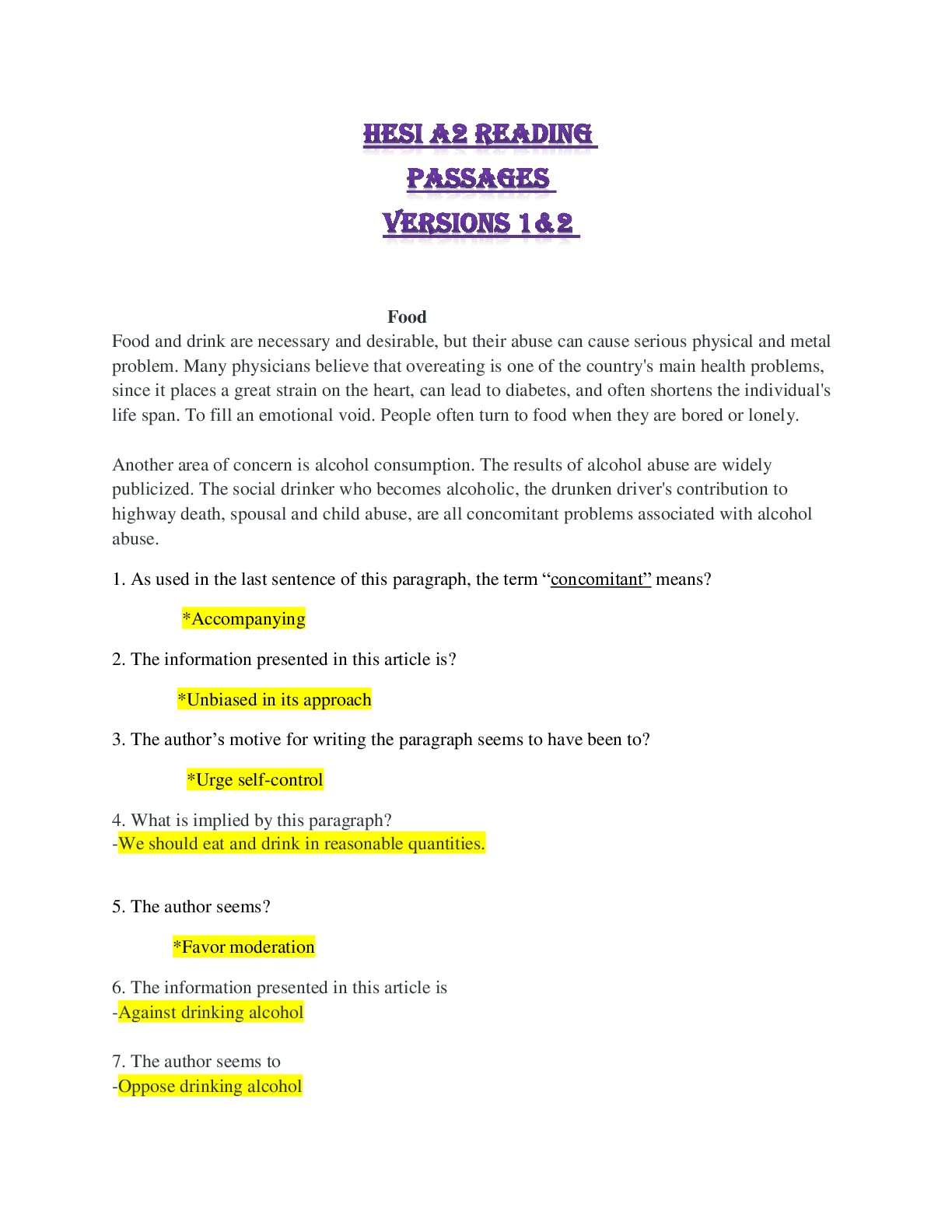
Also available in bundle (2)
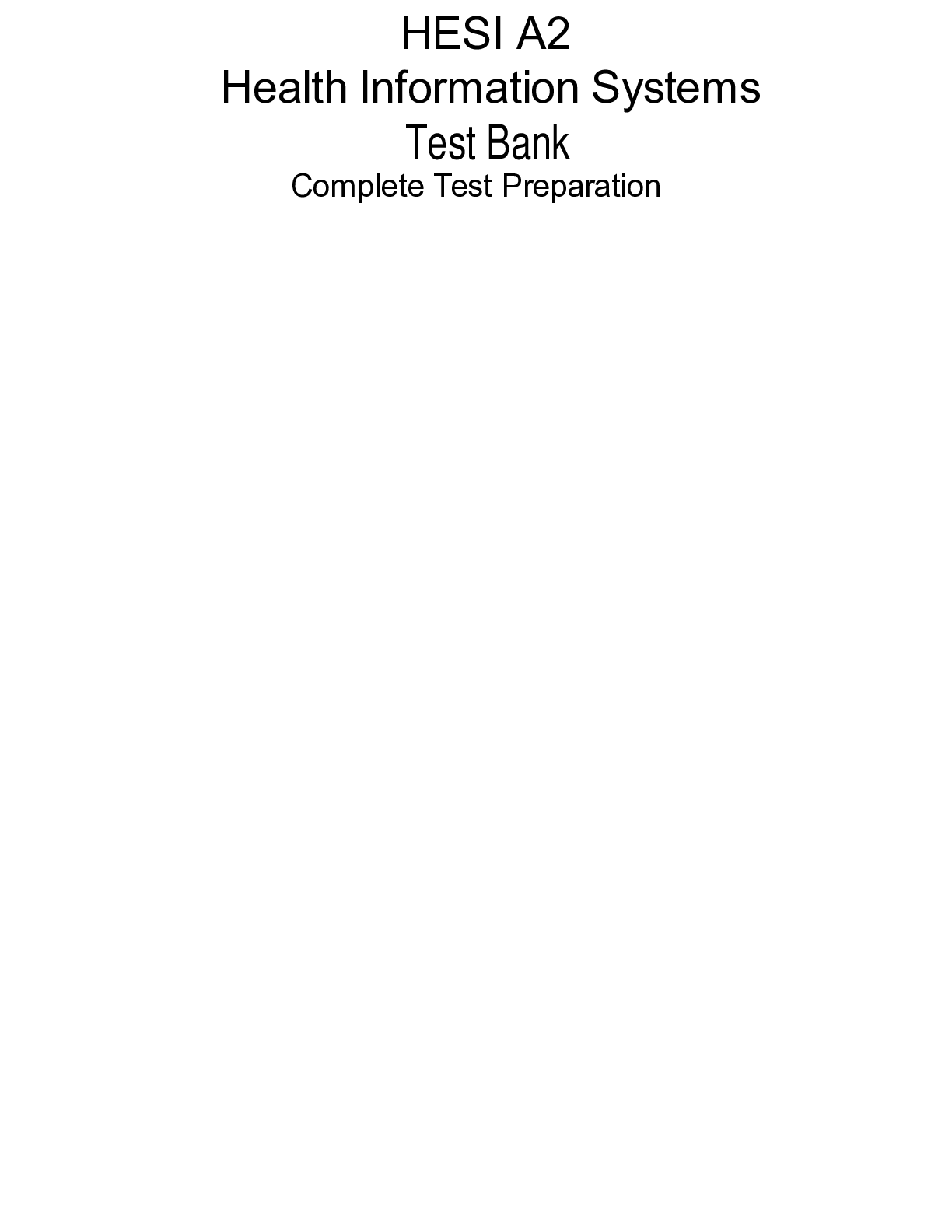
HESI A2 BIOLOGY| HESI A2 Health Information Systems Complete Test Preparation| Hesi A2 Reading v1 and v2| HESI A2 Health Information Systems Complete Test Preparation Test Bank| HESI A2 APP Vocabulary| HESI A2 Anatomy and Physiology Study Guide All versions| HESI A2 Anatomy and Physiology V1| HESI A2 - Math - Practice Exam| Hesi A2 Reading
HESI A2 BIOLOGY| HESI A2 Health Information Systems Complete Test Preparation| Hesi A2 Reading v1 and v2| HESI A2 Health Information Systems Complete Test Preparation Test Bank| HESI A2 APP Vocabular...
By Bobweiss 3 years ago
$30
10
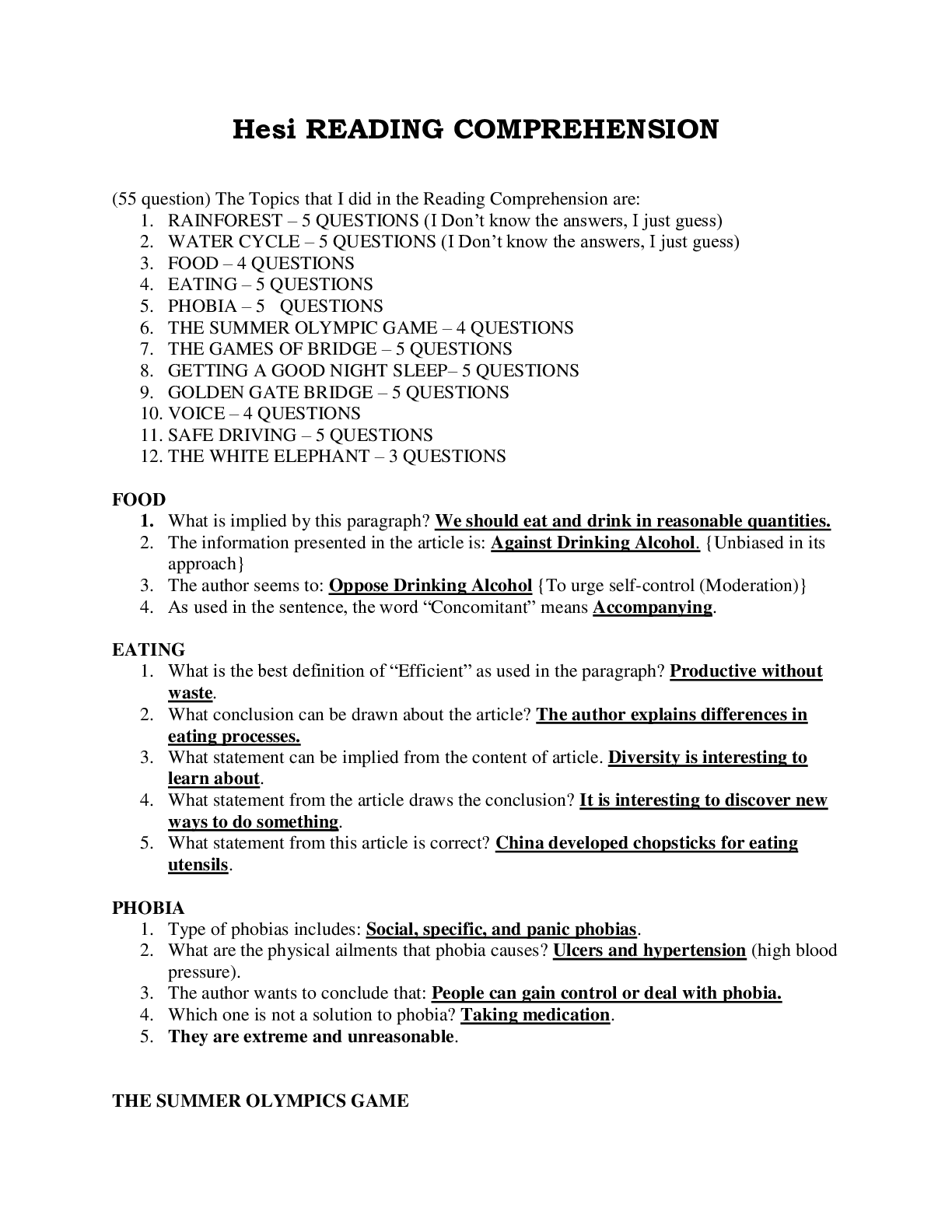
Hesi A2 biology, grammar, chemistry, vocabulary, Reading comprehension as well as Anatomy and Physiology; different versions
This bundle contains HESI A2 from various categories for example; biology, grammar, chemistry, vocabulary, Reading comprehension as well as Anatomy and Physiology from different versions
By Bobweiss 3 years ago
$27
8
Reviews( 0 )
Document information
Connected school, study & course
About the document
Uploaded On
Jan 27, 2021
Number of pages
54
Written in
Additional information
This document has been written for:
Uploaded
Jan 27, 2021
Downloads
1
Views
245


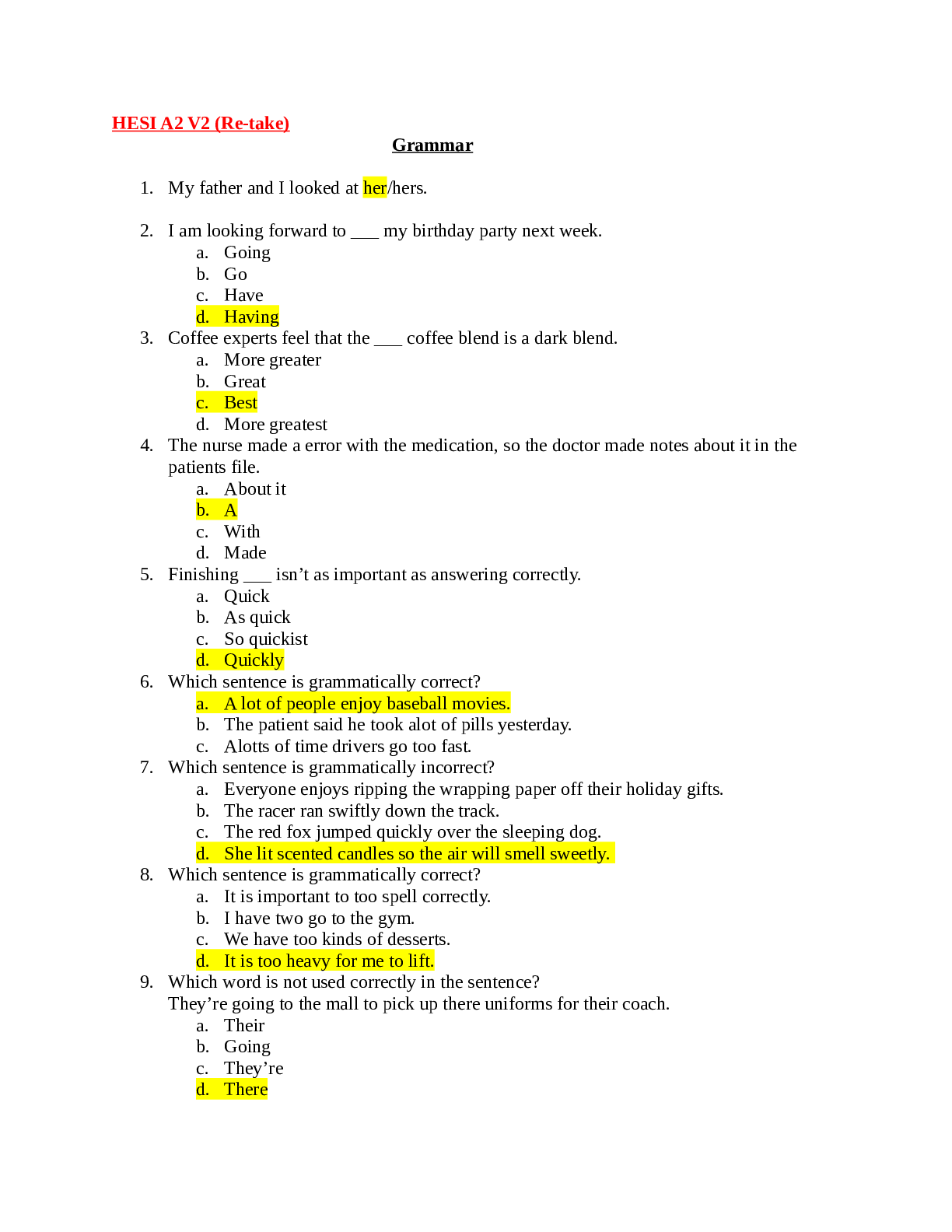

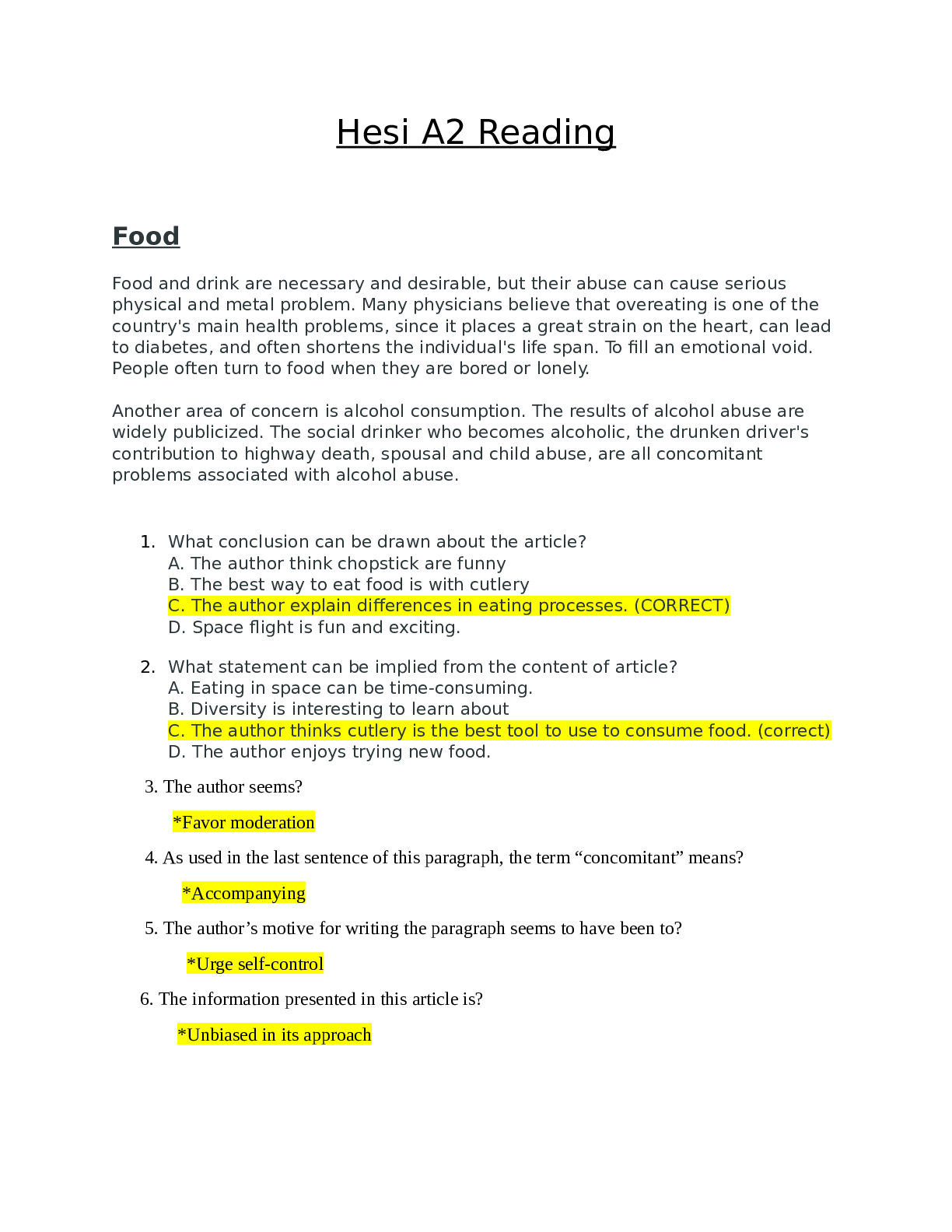
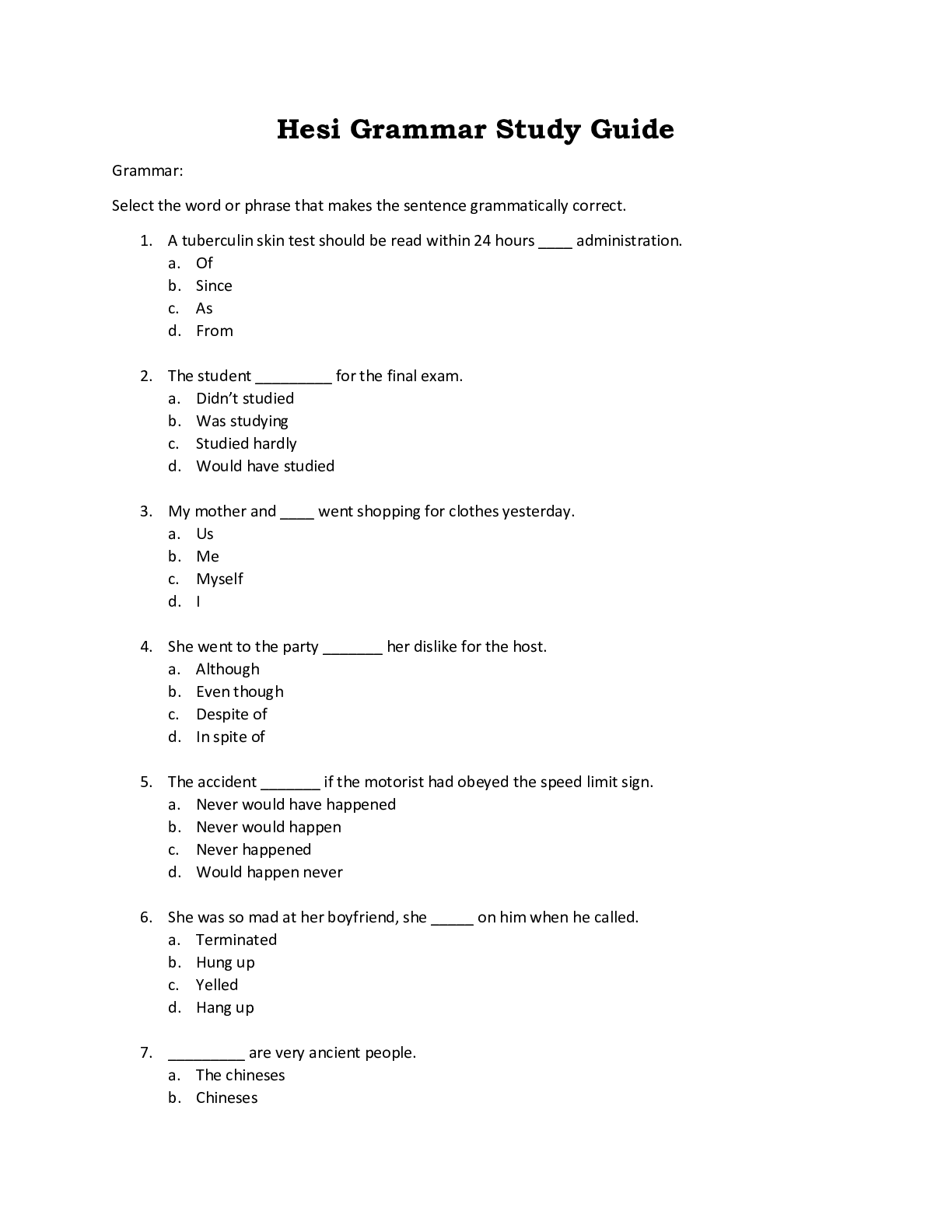

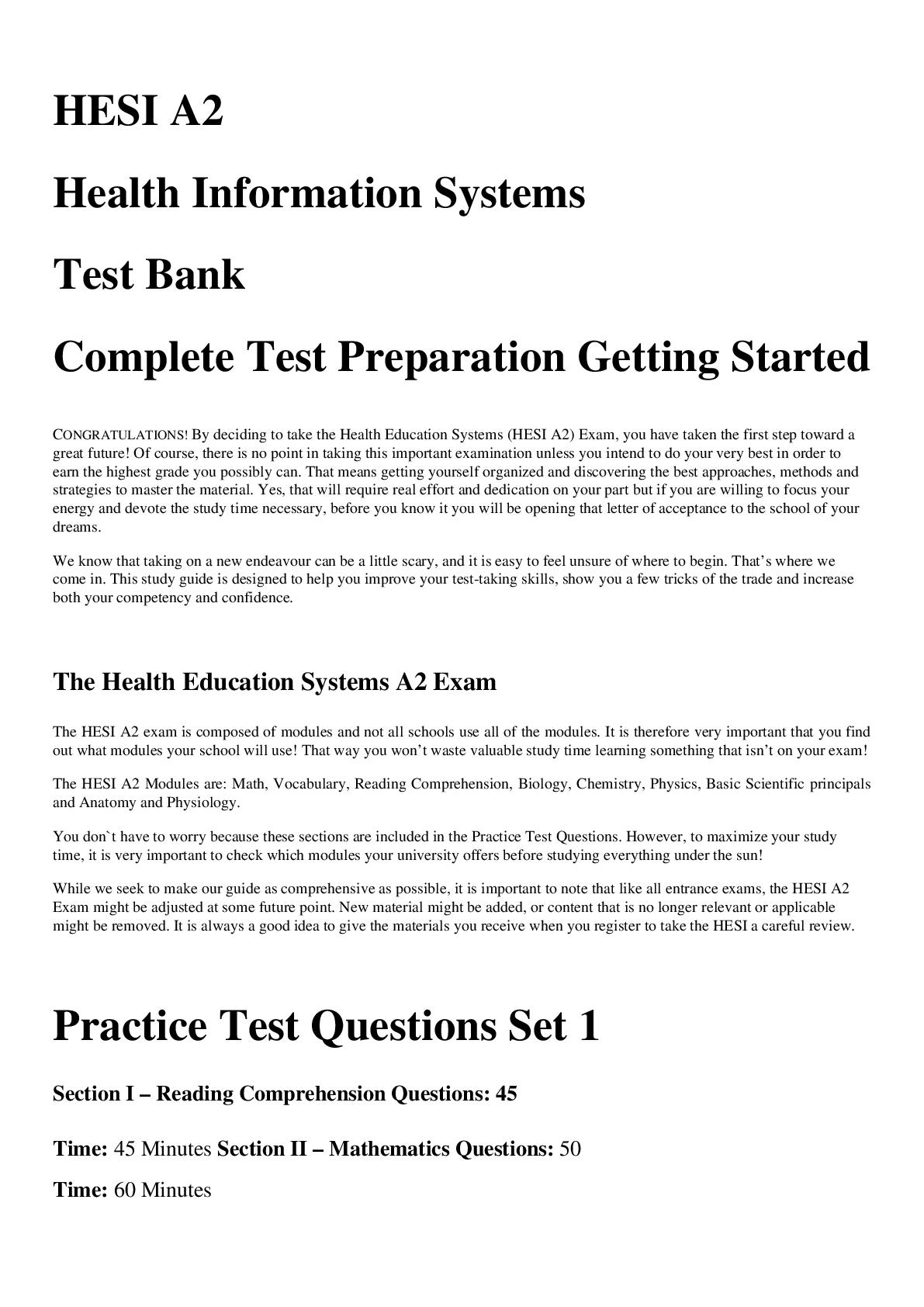
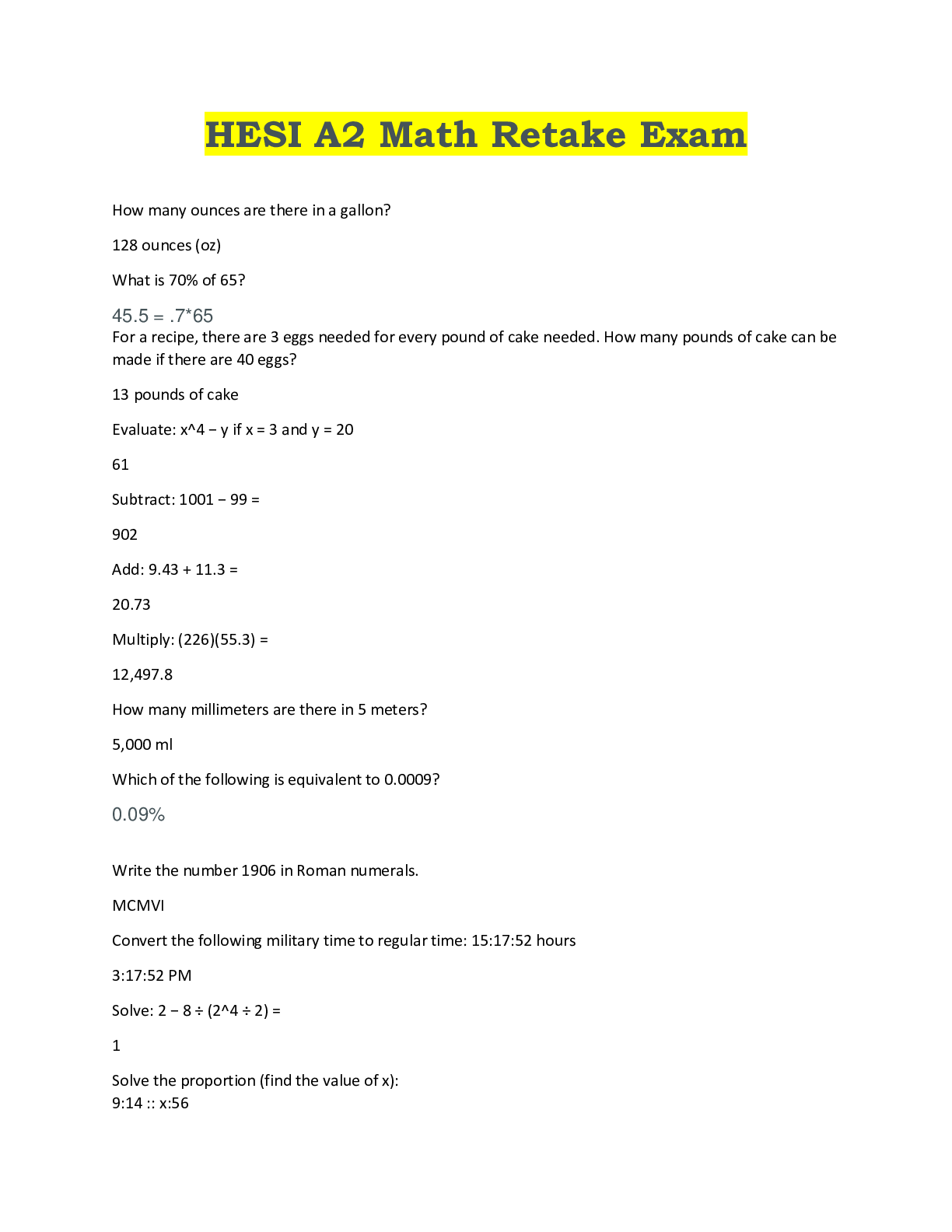
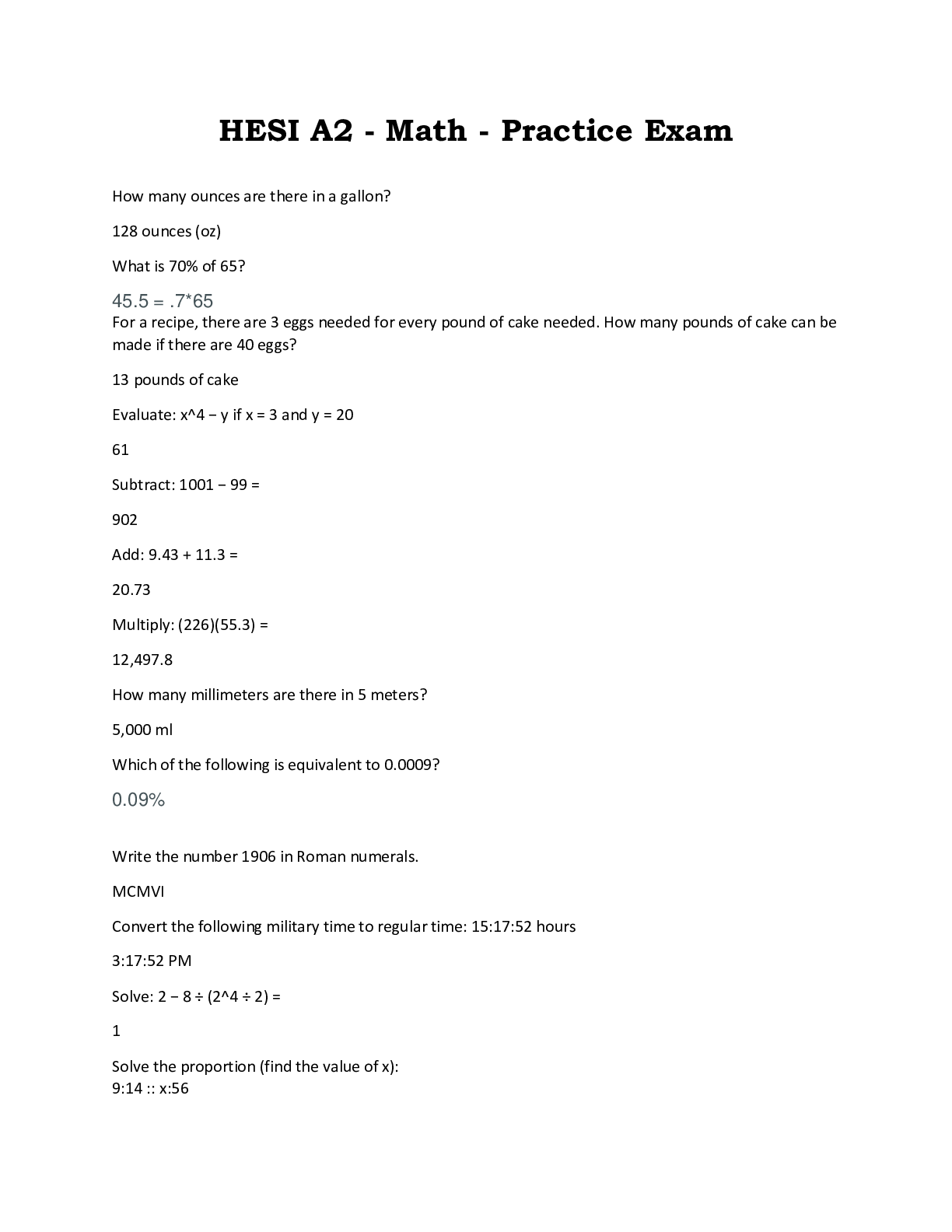
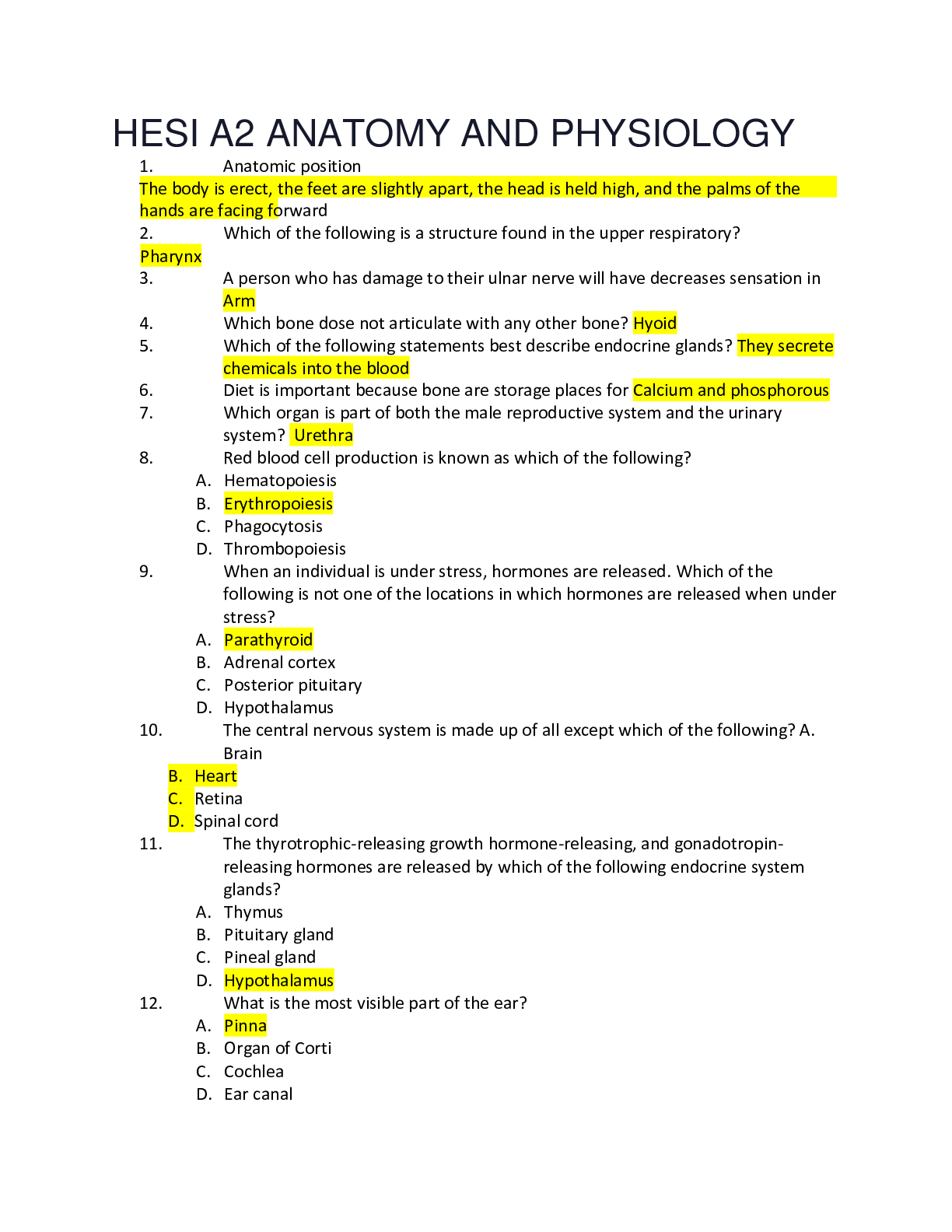
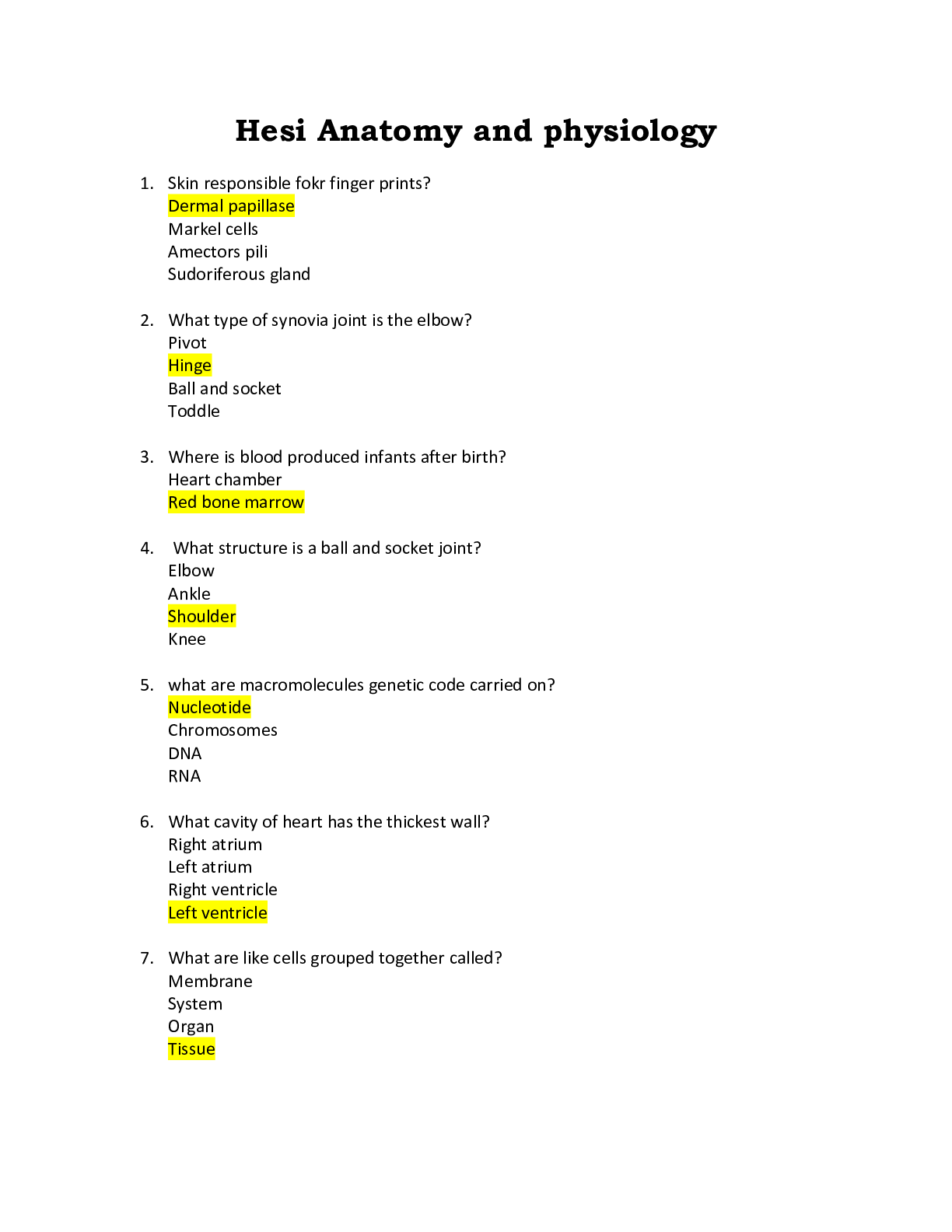
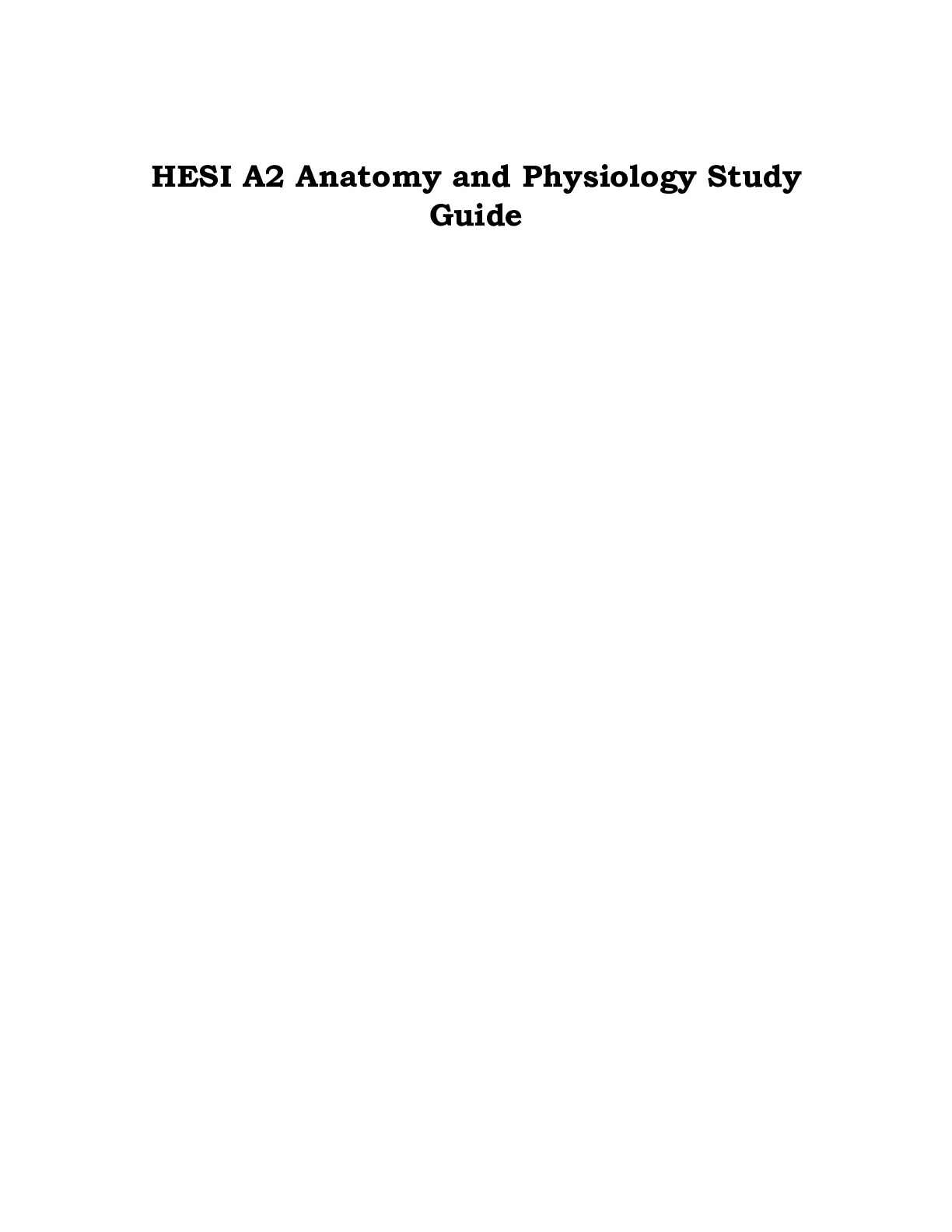
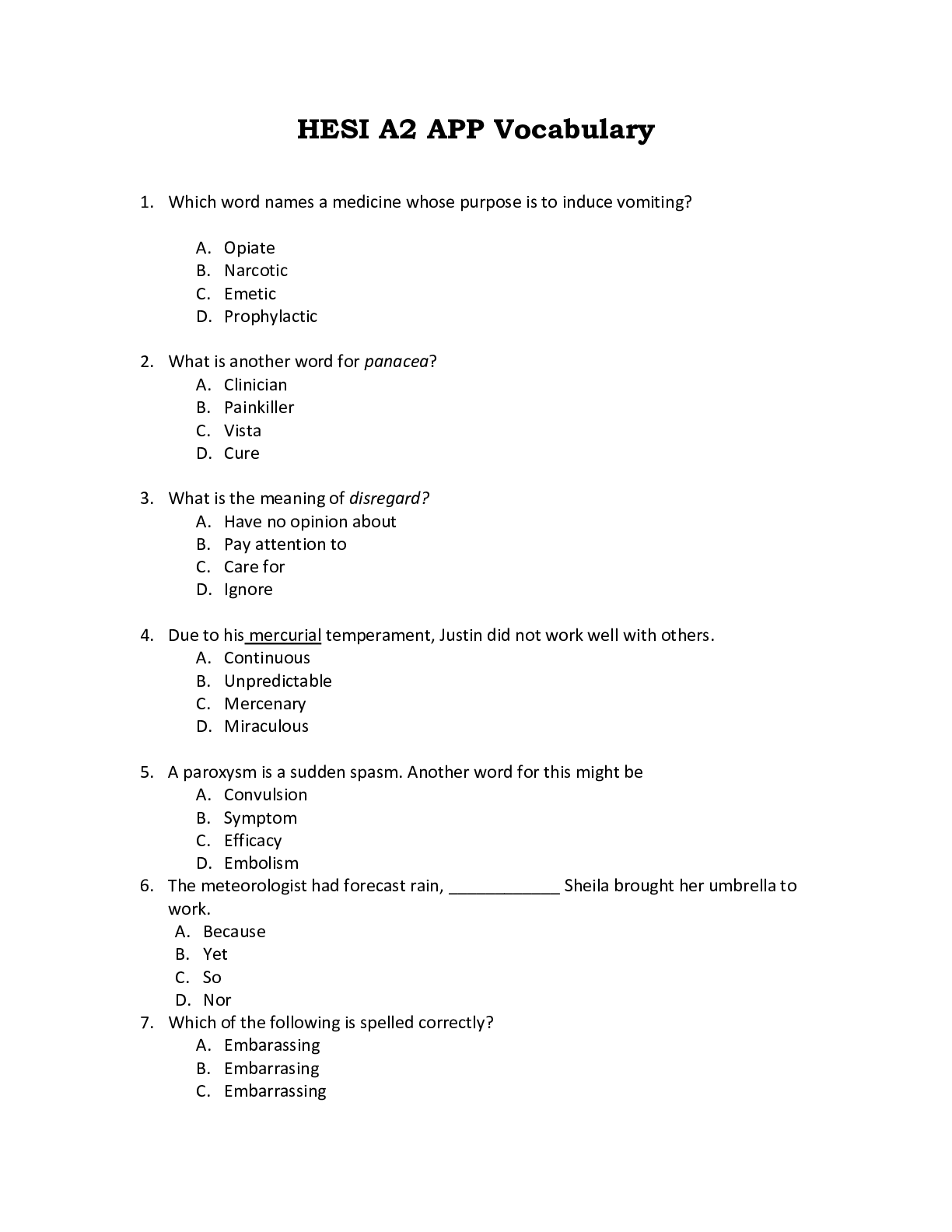
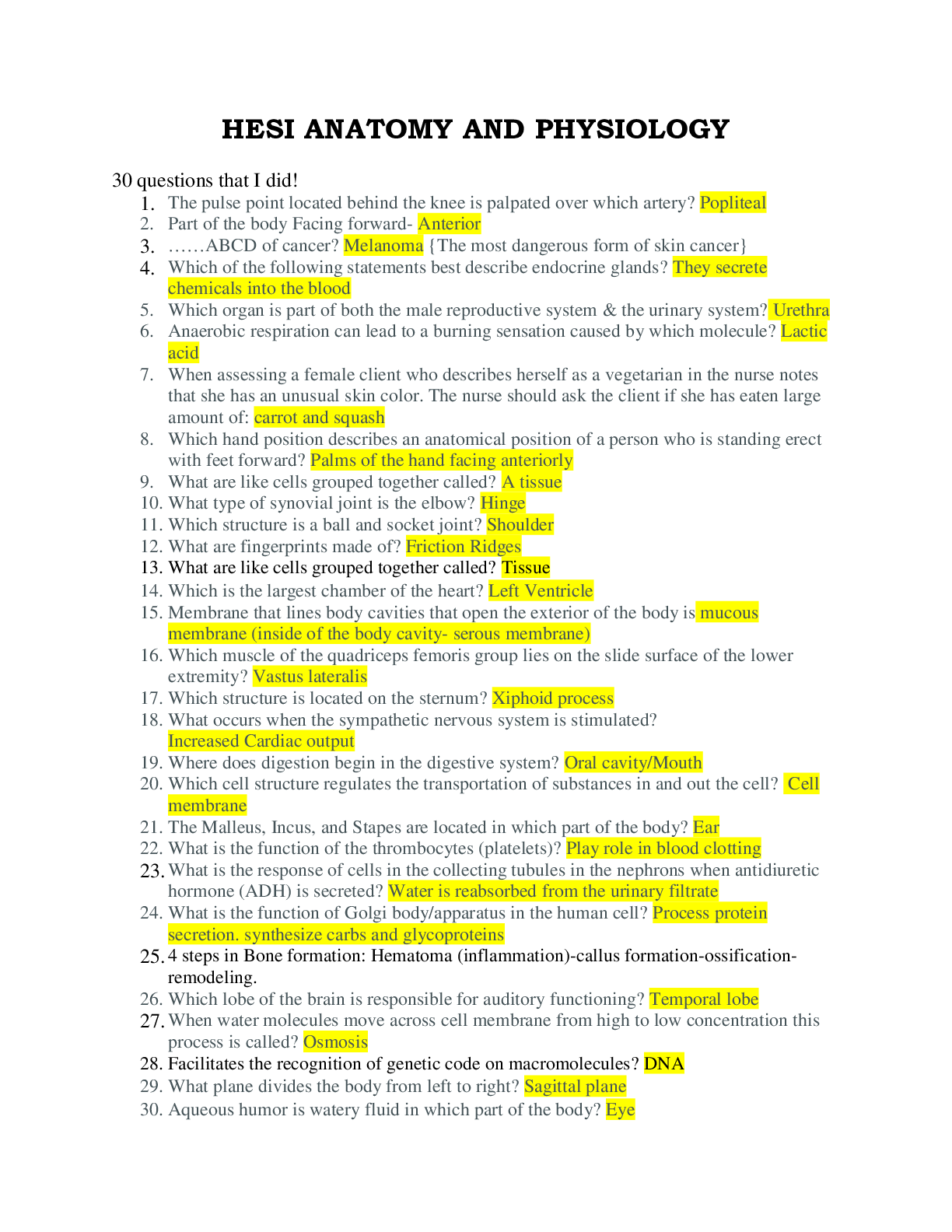




 (1).png)



